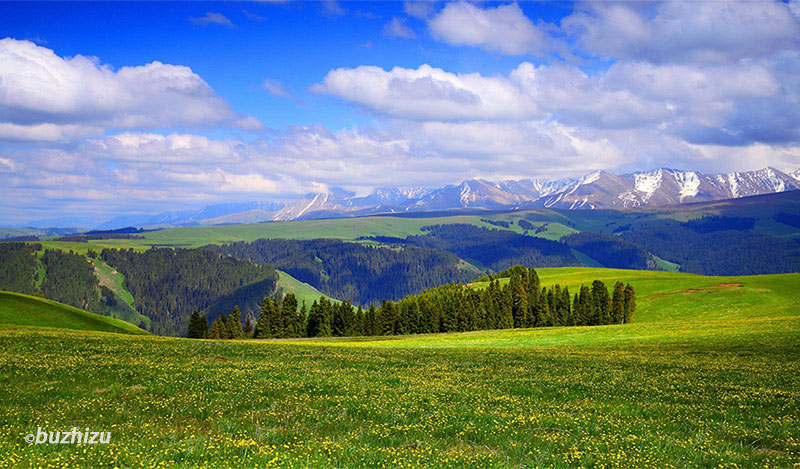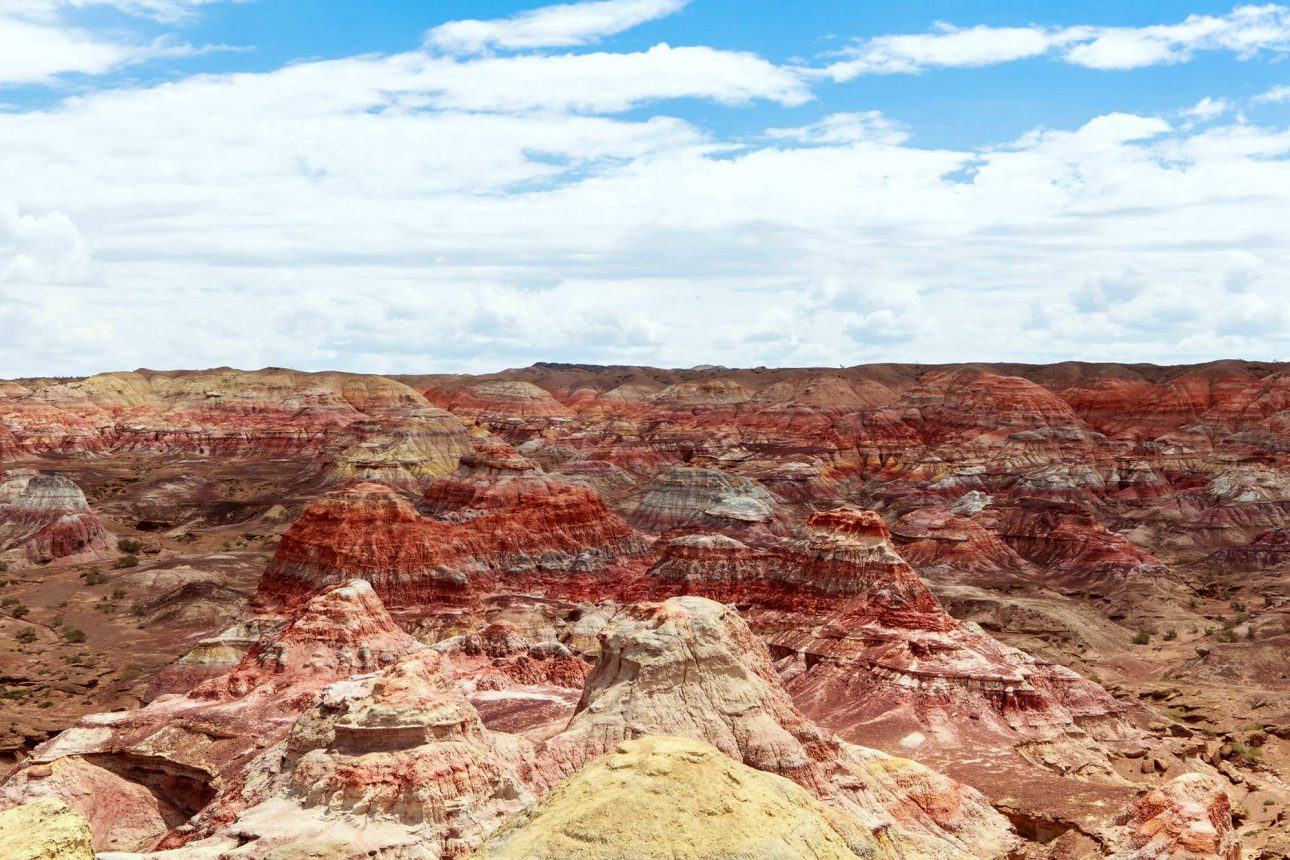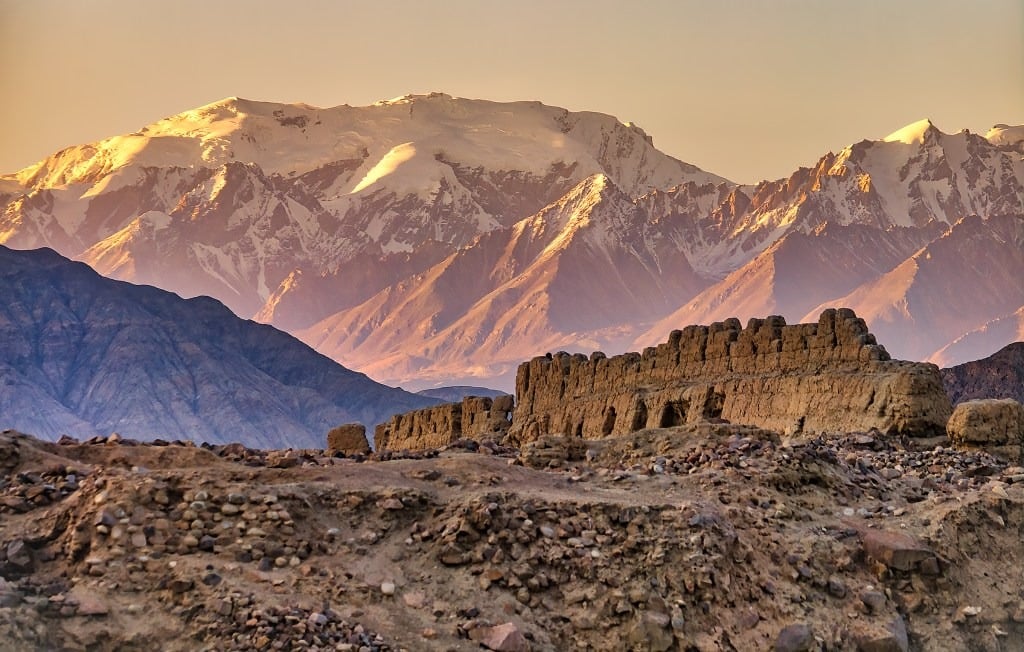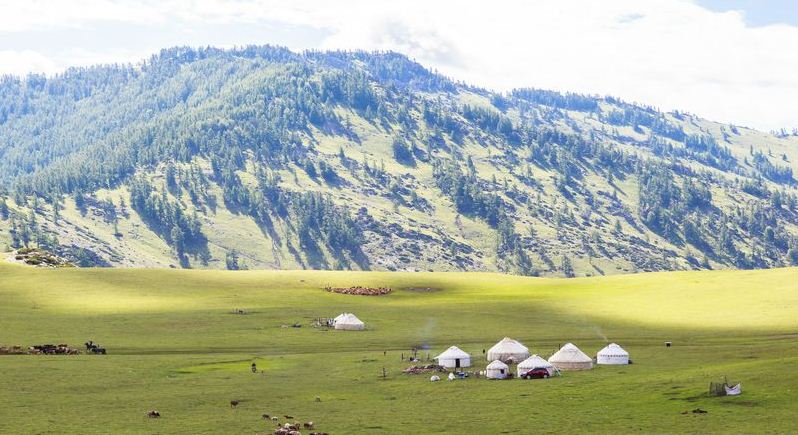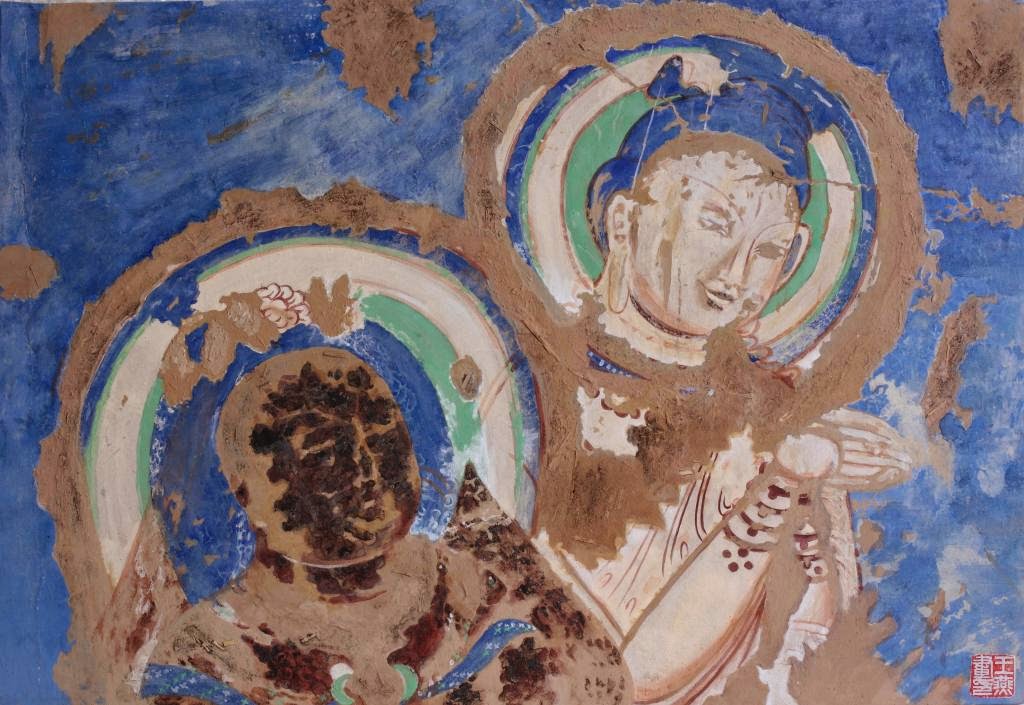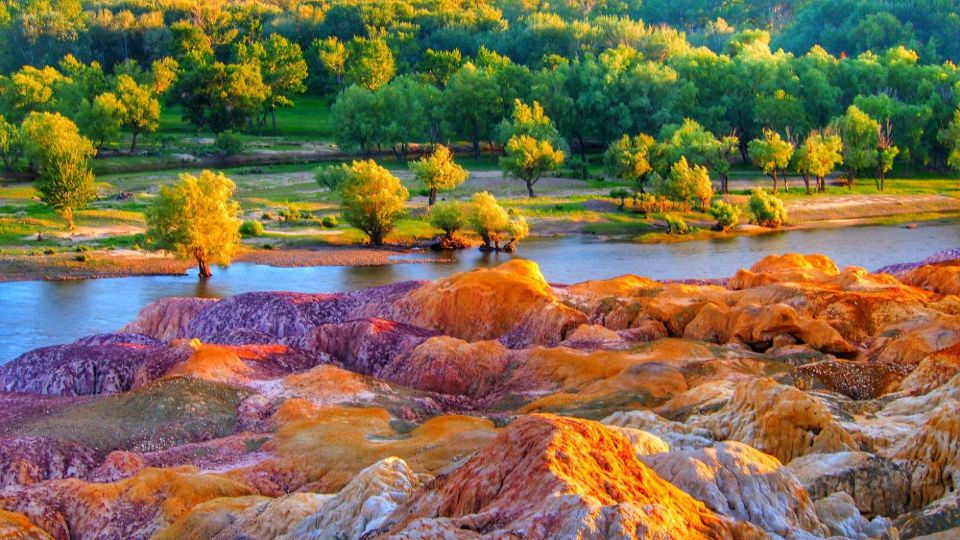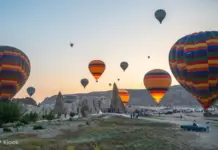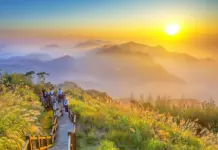Jiaohe Ancient Town is part of the UNESCO world cultural heritage “Silk Road”. Named after the two converging rivers, this place is shaped like a leaf with a scale of clay architecture. Jiaohe Ancient Town is famous as the most complete ruins in China. It is also a worth visit Xinjiang tourist place on the ancient Silk Road. Now, visitors can see many small but complete rammed earth buildings. The entire city is like a giant ancient sculpture, showing a unique architectural style.
- Xinjiang blog — A journey to the paradise on earth
- The ULTIMATE Lijiang travel guide: Top things to do, where to visit, stay, eat & MORE
- The FULLEST guide to Fenghuang Ancient Town: Top things to do, Eat, Tips & MORE
- Macau itinerary 2 days: How to spend 2 days in Macau perfectly from Hong Kong
- Must do in Macau: 11+ best things to do in Macau for First-Time Travelers
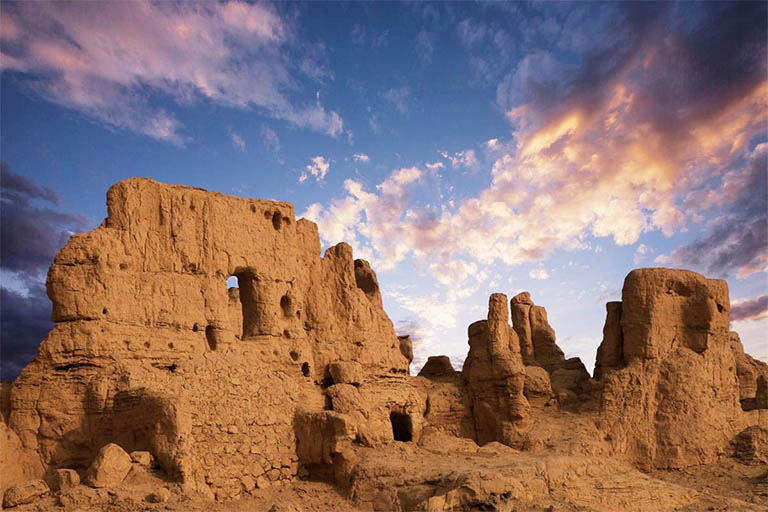
Jiaohe Ancient City resembles a giant military fortress standing on a 30-meter-high loess pedestal. It is now a must-see site in Turpan, and we can still find traces of historical travel in the ruins. It is best to go there in the late afternoon to avoid the heat and catch the sunset.
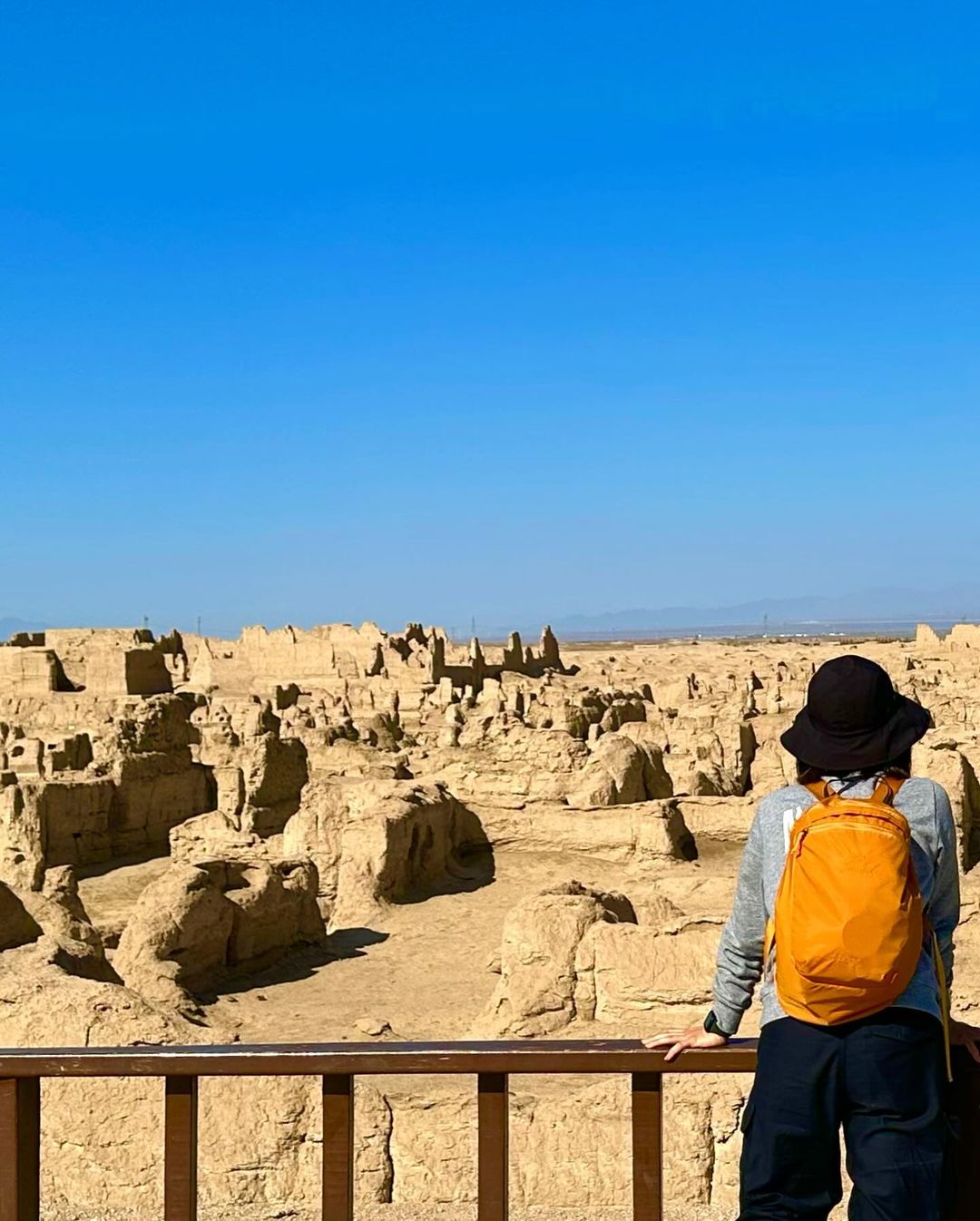
Immersed in China’s cleanest lake – Lake Sayram
Sayram Lake, also known as Sailimu Lake, is the largest alpine lake in Xinjiang and the largest lake above sea level. Located in the high mountain basin of Tianshan Mountain, it is known as the Lake of the Mountains by the locals. Besides, it has received many other titles such as AAAAA National Scenic Area, National Historic Site, Pearl of the Ancient Silk Road, etc. It is most attractive for its spectacular scenery, including brilliant blue lakes, lush green forests, snow-capped peaks, lush green grasslands and the most charming wildflowers if you visit in late spring to early autumn.
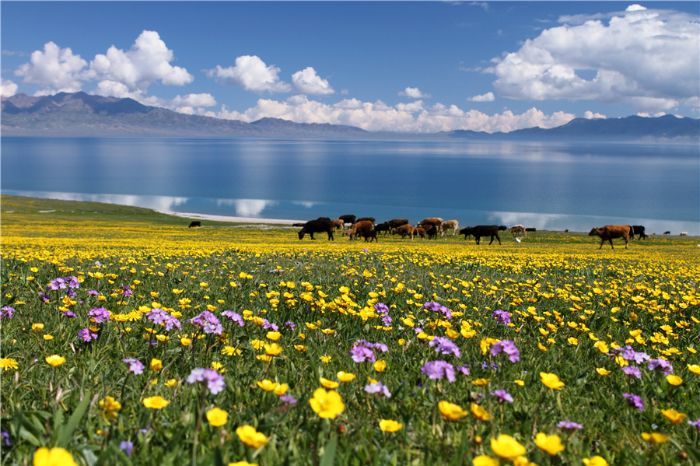
Sayram Lake is known as “the last tear of the Atlantic Ocean”, as this is the last place where the warm ocean current can reach after traveling 7,000 km. With an altitude of 2,000 m and an area of 450 km2, Sayram Lake is the highest mountain lake in Xinjiang. Sayram Lake’s water is as blue as the sky, as clear as glass. Along the lake are vast grasslands with beautiful wild flowers, horses leisurely grazing. A little further away are snow-capped peaks and lush forests.
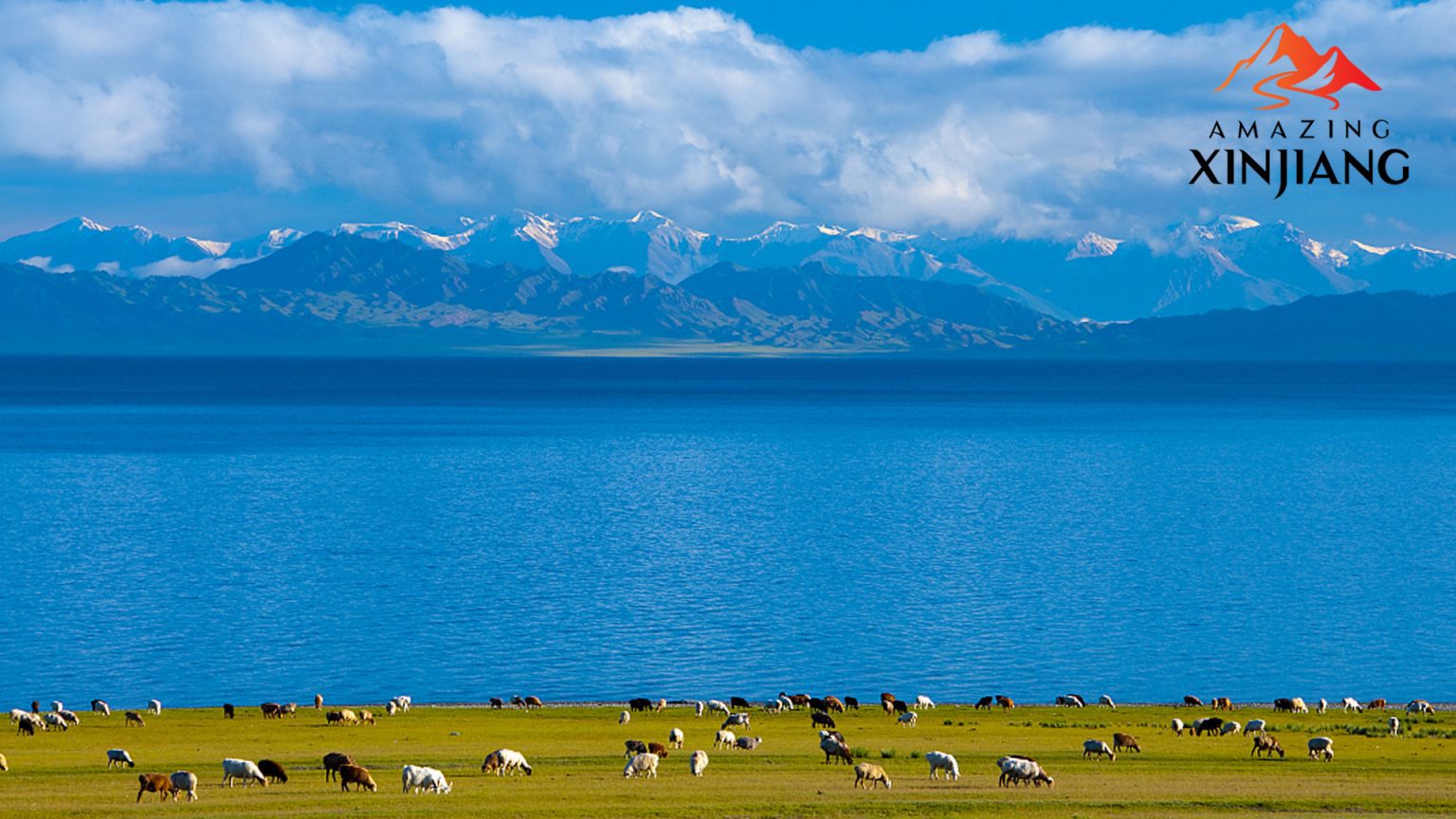
Explore Kashgar market

Bazaar is the Uyghur word for market and it is popular throughout Xinjiang. Kashgar Market is a place that truly reflects the local market atmosphere. There are more than 5,000 shops and stalls selling a variety of Xinjiang products and specialties. From dried fruits, nuts, snacks, to clothes, hats, musical instruments, handicrafts… Tourists can stroll around the market, buy souvenirs and try some local dishes.

Grand Bazaar
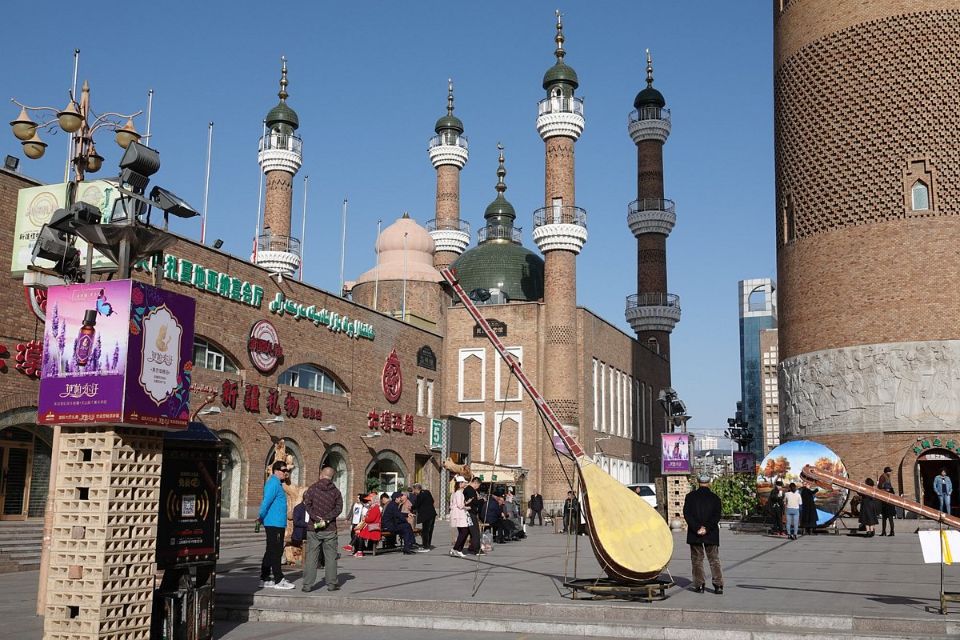
This is the largest market in Xinjiang located in the capital city of Urumqi, the architectural style of the Grand Bazaar is grand in scale and has a strong Islamic style. Strolling along the narrow streets of the Grand Bazaar in Xinjiang, the first thing that catches your eye is the colorful ceramic tiles, intricate wood carvings and splendid decorations.
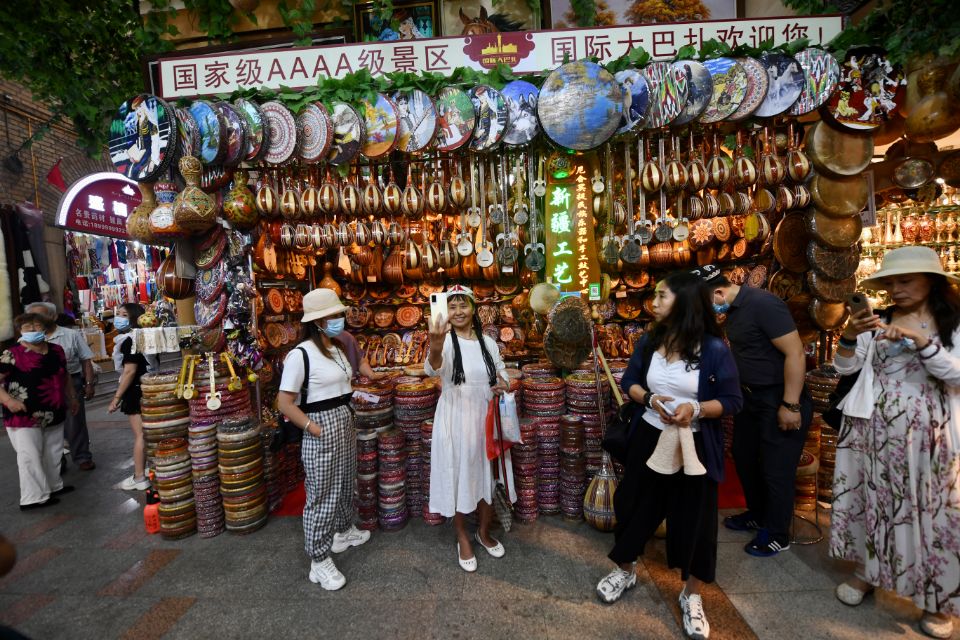
The market inside sells a myriad of Xinjiang people’s products, which are rich and exquisite. The Grand Bazaar is also a gathering place for all kinds of Xinjiang delicacies such as: Hami melon, special ice cream, super delicious fruit juice, etc.
Enjoy the unique three-dimensional grassland view in Karajun
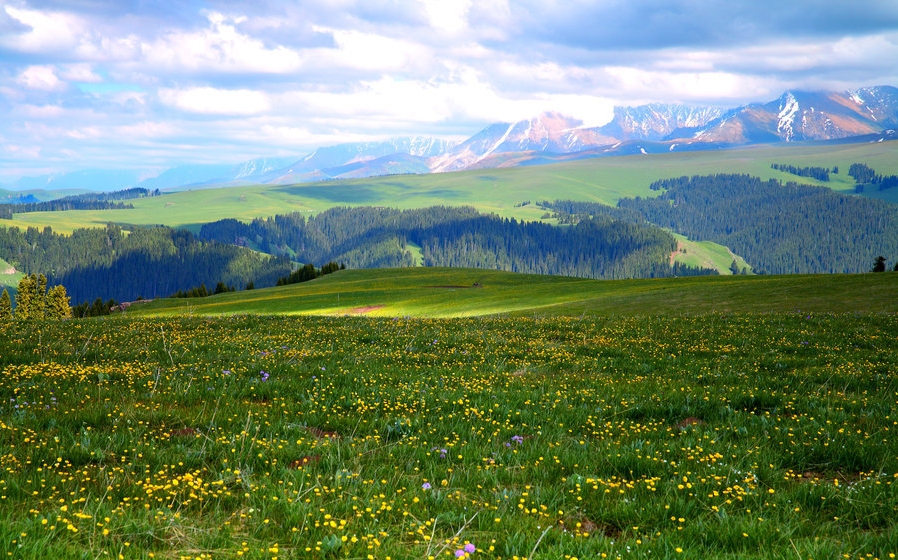
Karajun means “vast black grassland” in Kazak. It was once the capital of the Wusun Kingdom, the largest nomadic nation in the Western Regions. Today, Karajun is the summer pasture of Kazakh nomads. Karajun Mountain is flanked by ravines and undulating mountain ranges covered with dense primeval spruce forests. With majestic snow-capped mountains in the background, Karajun Grassland offers a stunning three-dimensional grassland view.
Driving on the Taklamakan Desert highway
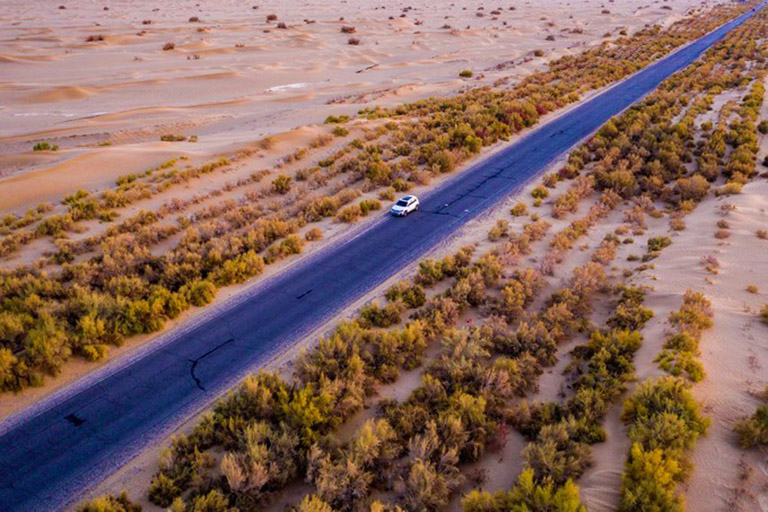
The Taklamakan Desert is the largest desert in China and the second largest drifting desert in the world. The desert stretches 1,000 km from east to west, 400 km from north to south. With little rainfall and constantly changing sand dunes, exploring the Taklamakan Desert is difficult. However, there are several highways that cross the Taklamakan. When sitting in the car, you can see endless sand dunes of all shapes. Some are smooth sand, some look like pyramids, hills, dragons, feathers, fish scales… Looking out the window, you will definitely feel that you and your car are so small, like a boat on the sea.
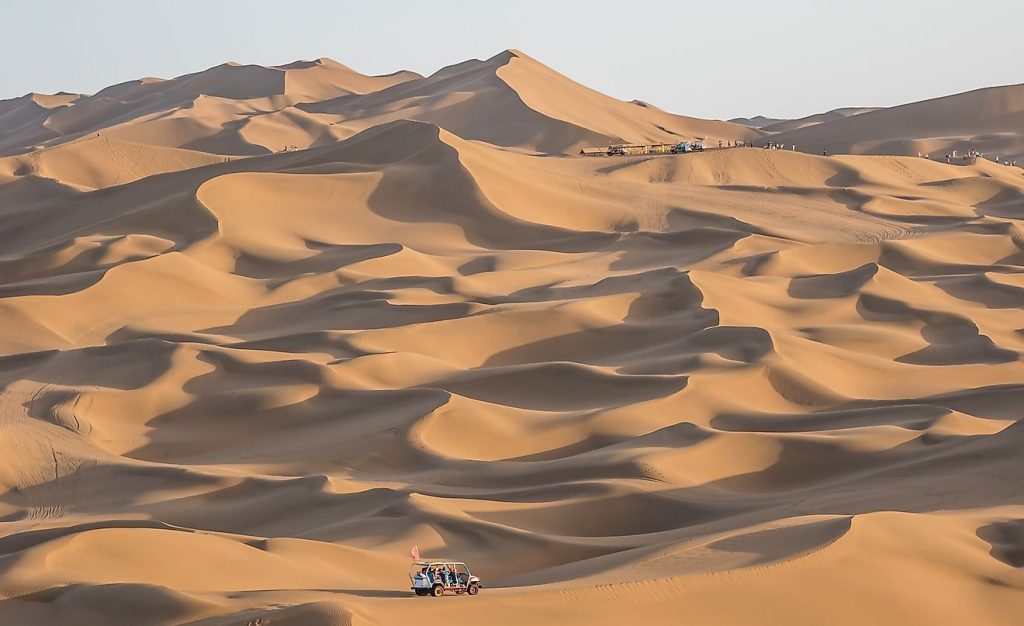
As one of the largest and harshest deserts in the world, the Taklamakan stands out with its endless golden sand dunes and beautiful sunsets. Visitors can experience the vast, wild feeling and participate in activities such as camel riding or driving a Jeep on the sand.
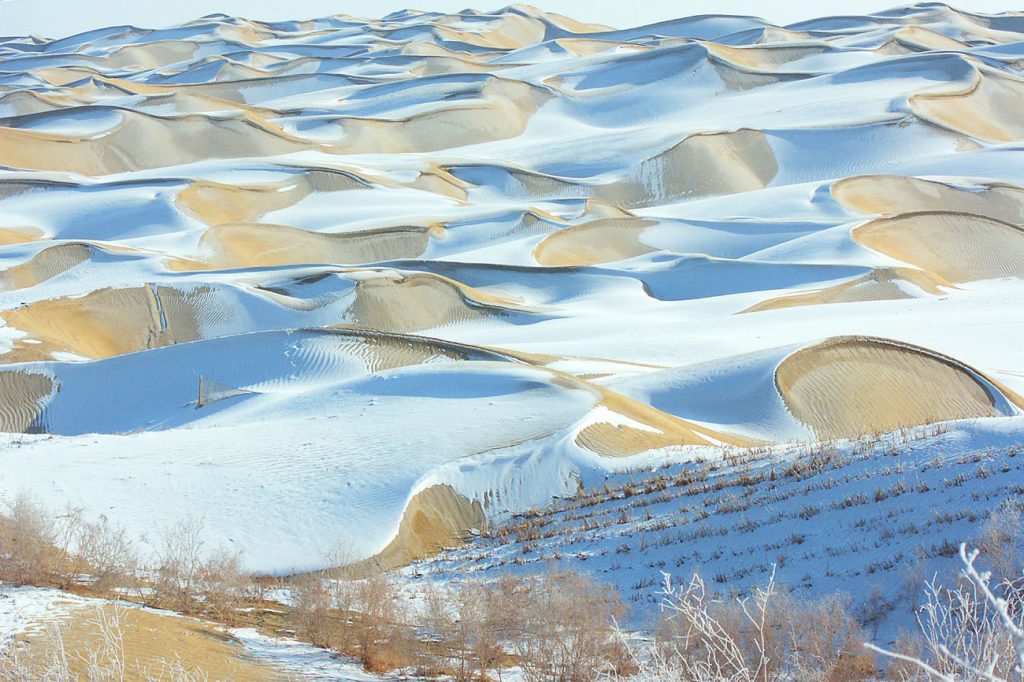
In particular, the northern part of this desert is Flaming Mountains, which is not only famous for its majestic natural landscape but also associated with many stories and legends in Chinese culture, especially the story in the work “Journey to the West”. According to legend, this is the battlefield of Sun Wukong and Niu Mo Wang (Bull Demon King), creating a special attraction for those who love culture and history.
Kumtag Desert
About 90km from the urban area of Turpan, Kumtag Desert is the closest desert to a city in the world. Because of its special location, where the southwest wind from Qijiaojin in the southern range of Tianshan Mountain meets and offsets the southwest wind passing through Dabacheng, the sand and gravel carried by the two winds are deposited here, forming the unique scenery of “desert with sand mountain” in the Kumtag Desert.
The sand in the Kumtag Desert is as soft as silk. With the change of light, the desert takes on different charming colors. Besides, there are many interesting activities that will make your trip more memorable, such as sand sliding, camel riding, jeep safari, etc.
Explore the stone city of Tashkurgan
Tashkurgan is short for “stone city” in Uyghur. Tashkurgan was once the palace of the Puli Kingdom. The middle and southern routes of the ancient Silk Road met here. But when the Qing Dynasty built a new town in the south, the stone city was gradually abandoned. Today, when traveling to Xinjiang, you can still see many destroyed city walls and ancient houses. Many ruins are scattered inside. Some coins and old books have been excavated here.
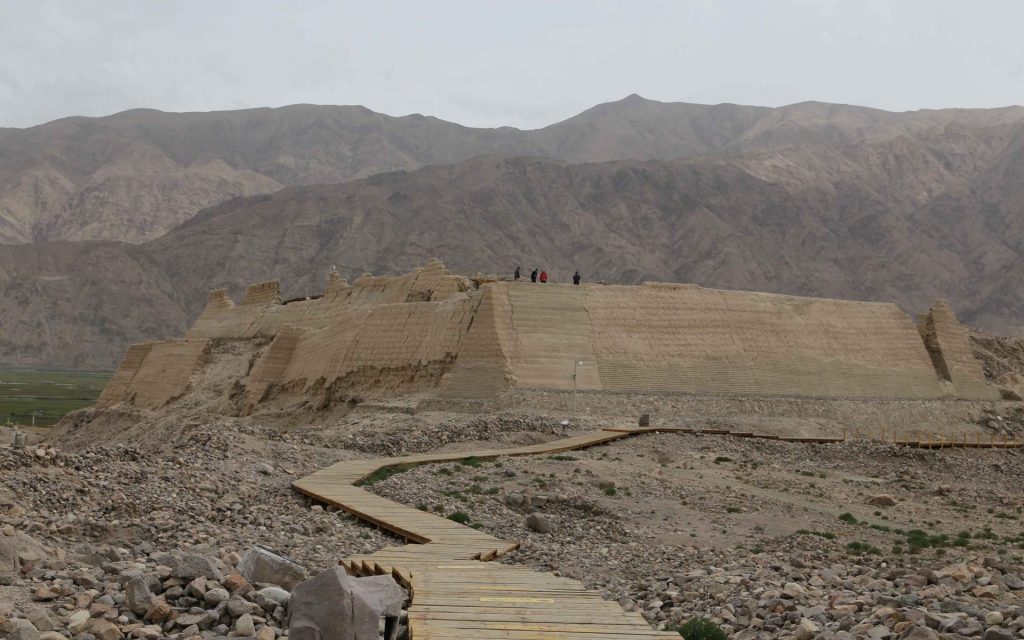
Ili
The ancients said that only when you come to Xinjiang will you know how vast China is, and only when you come to Ili will you see the beauty of Xinjiang. The scenery of Ili with four distinct seasons will surely fascinate you! Narati Grassland, Kalajun Praire, Huocheng Lavendor Farm, and Xiata Valley in the great Tianshan Mountains.
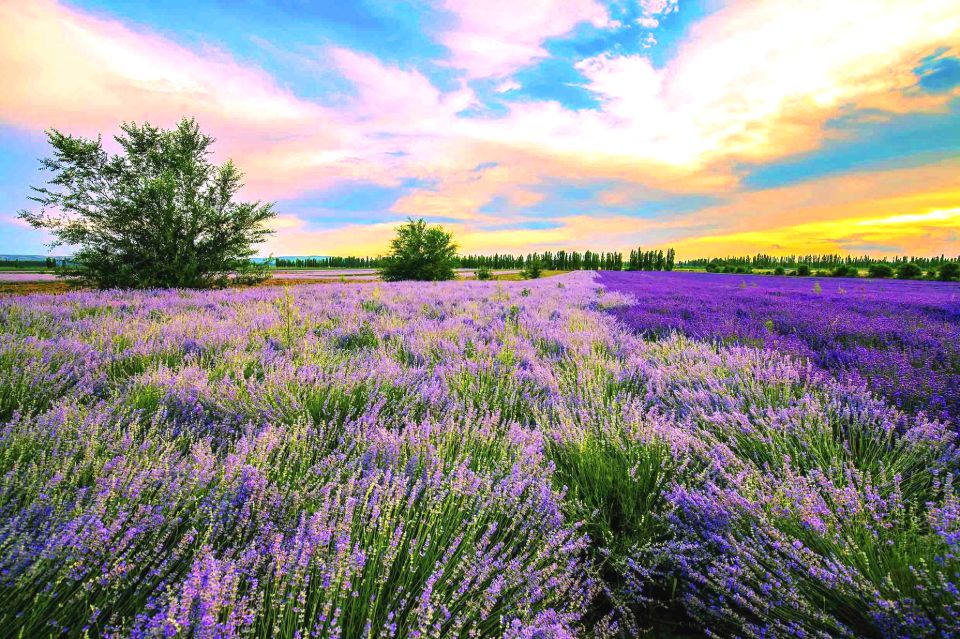
Bezeklik Thousand Buddha Caves
Bezeklik is a famous religious relic, where many Buddhist murals of historical and artistic value are preserved. Coming here, visitors will explore the unique architecture and learn about the history of Buddhism in Xinjiang. It is a treasure trove of Buddhist art with dozens of surviving caves and murals covering more than 1,200 square meters, proving that ancient Turpan (Gaochang Kingdom) was once a religious center.
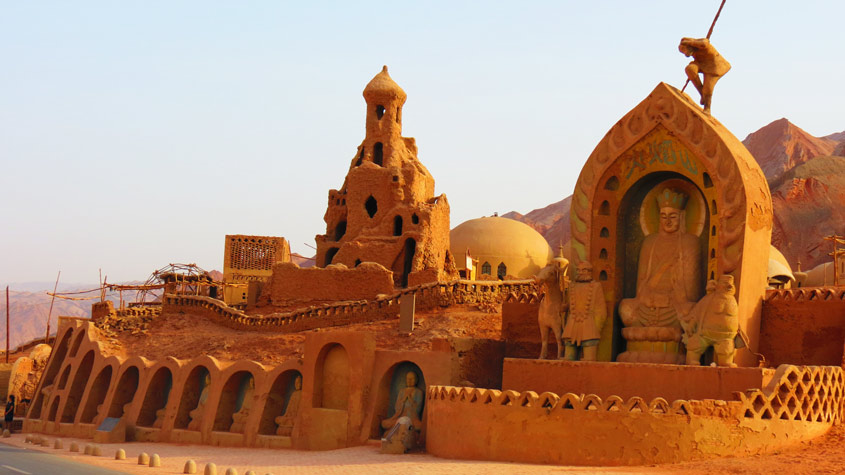
Bezeklik Caves are located on the cliff on the west bank of Mutougou, on the Volcano in the east of Turpan, Xinjiang. There were originally 83 caves, 57 of which still exist. Among them, more than 40 ancient murals cover a total area of 1,200 square meters. Among the existing caves in Turpan, Bezeklik has the most caves and the most murals. It is one of the largest Buddhist cave sites in Xinjiang and is also of the highest standard, having been the royal temple of the Huihu Kingdom (AD 848 – early 13th century) in Gaochang.
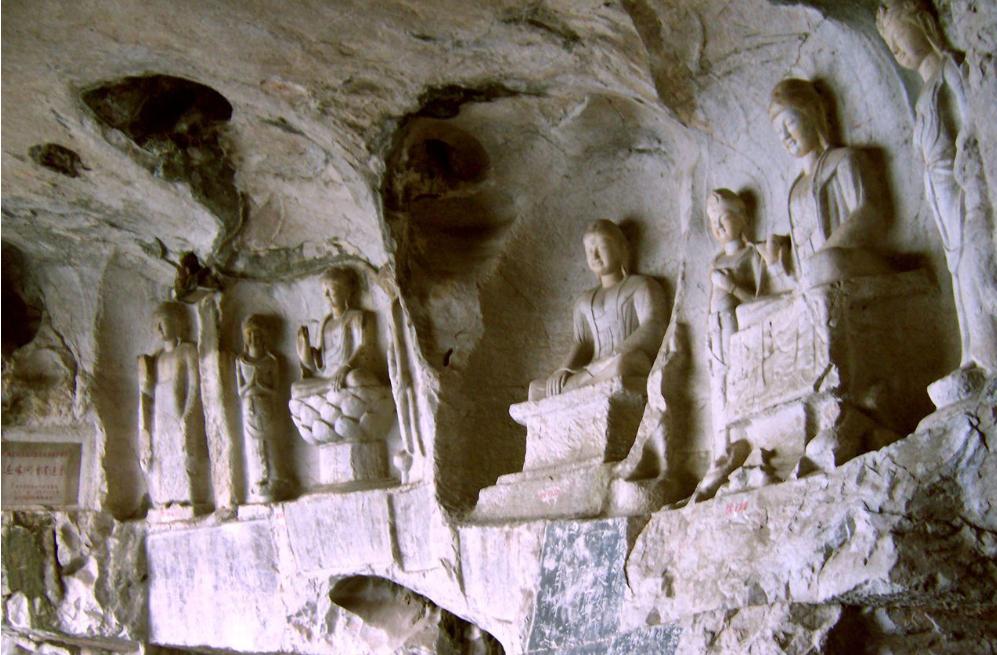
Huoyan Mountain (Flaming Mountains)
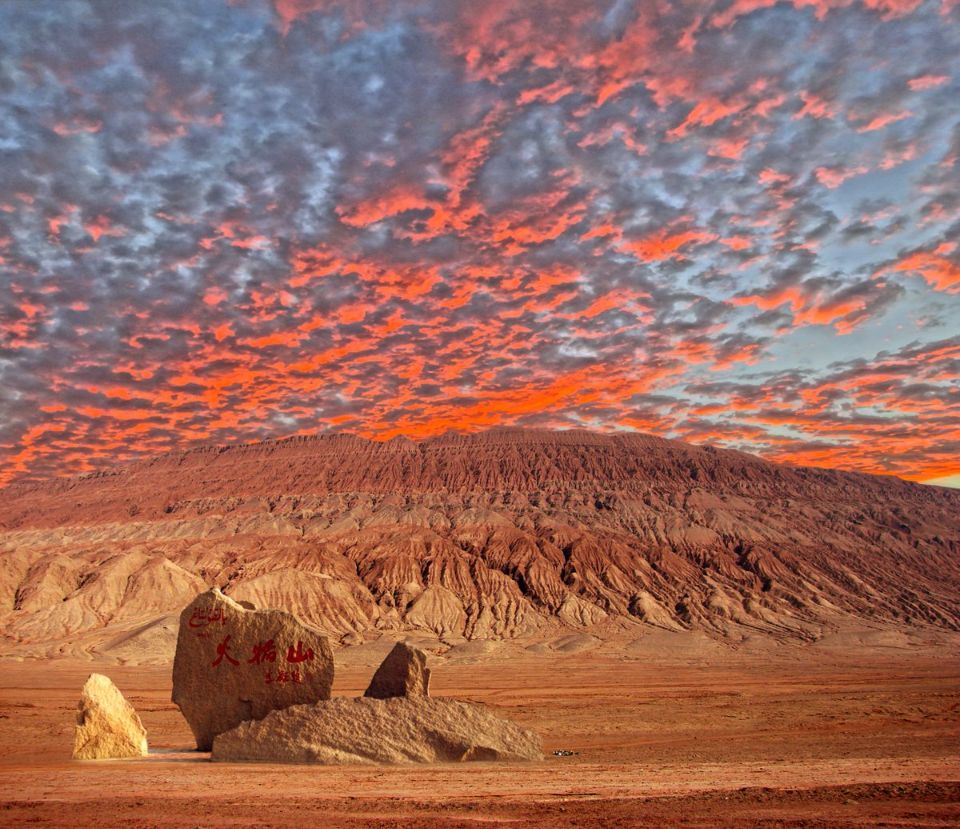
Located near the city of Turpan (Turufan), Flaming Mountains is notable for its dramatic landscape and its characteristic temperature. Flaming Mountains is a dry terrain with red mountain ranges, creating a natural picture that looks like it is being burned by fire. The red-orange cliffs and the hot climate of the area contribute to the image of a place being “burned by fire”, with temperatures reaching up to 70°C.
This is one of the unique destinations that attracts tourists who love to explore new landscapes. This is also a place associated with childhood through the classic film “Journey to the West”.
Id Kah Mosque
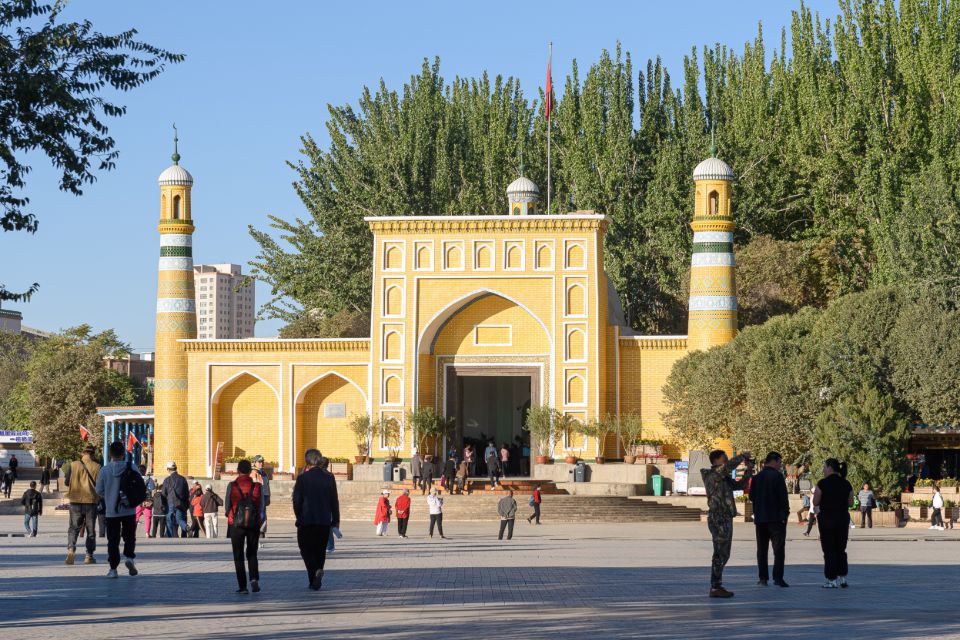
Id Kah Mosque is located in the center of Kashgar’s old town, the name “Id Kah” means “festival, happy square”. This is an Islamic architectural complex with national style and religious colors, mainly yellow. Not only is it the largest mosque in Xinjiang, Id Kah is also one of the largest and most standard mosques in China.
Built in 1442 AD, this mosque has a history of more than 500 years. During the annual “Aid al-Adha” festival, more than 20,000 believers will gather here. Note that you are not allowed to take photos inside the church and you need to ask permission before taking photos.
Mushtag – South Xinjiang Peak
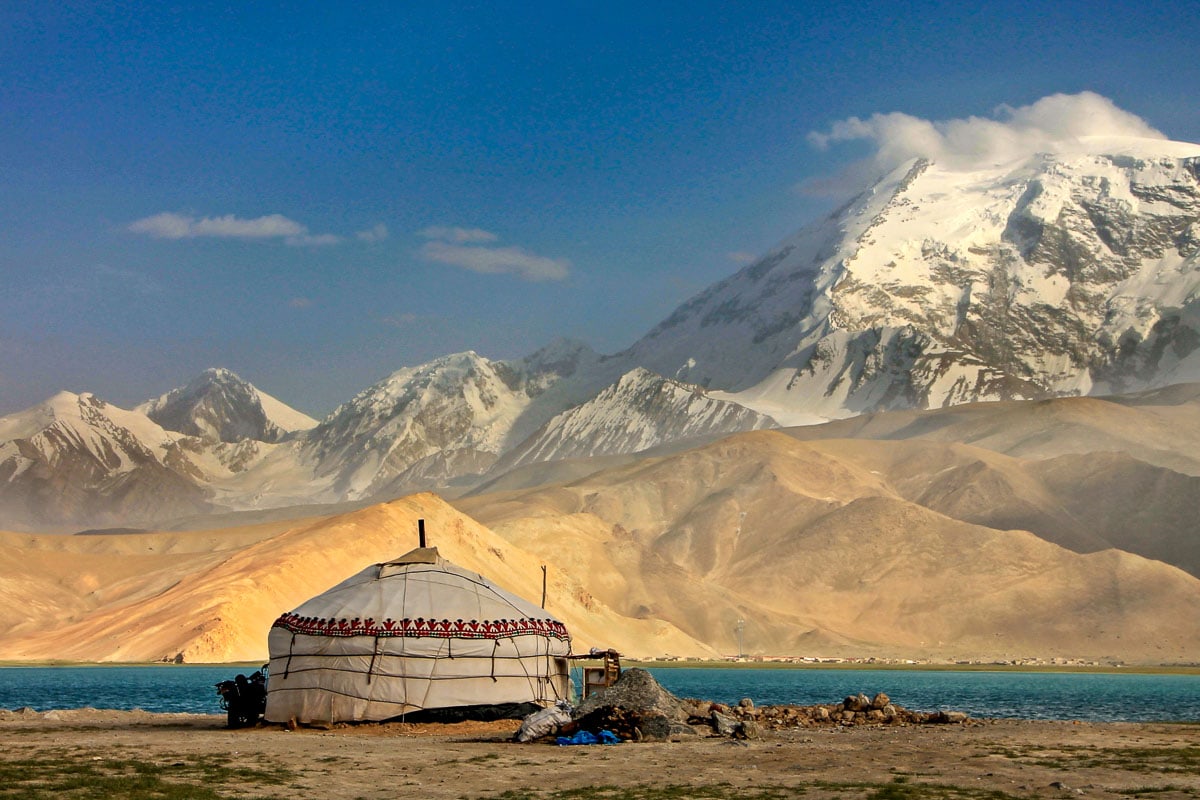
This is the only snow mountain that can be climbed commercially. If you are not a professional climber, you can still drive an ATV straight to the base camp and approach the glacier without any special equipment.
Karakul Lake
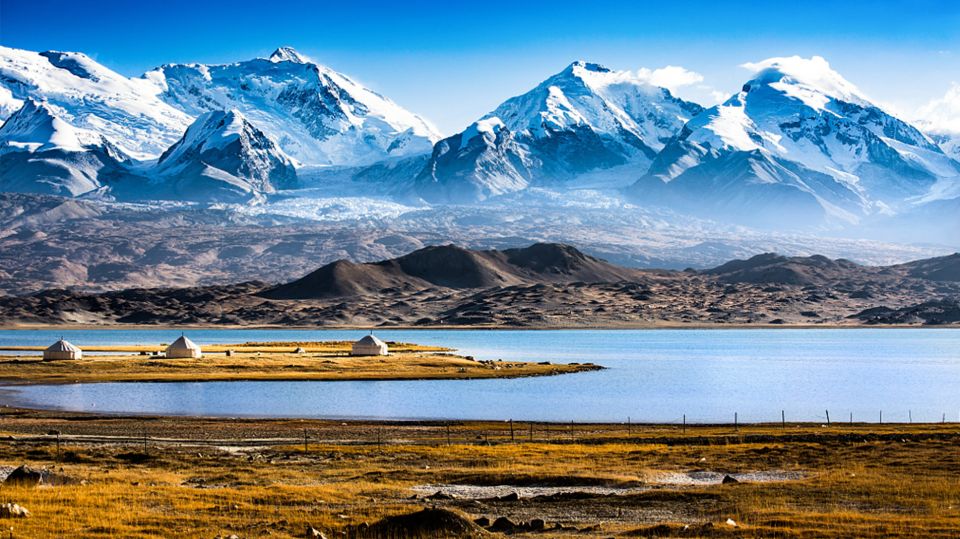
The peak reflects on the surface of Karakul Lake, surrounded by ice peaks and snow-capped mountains, creating a beautiful scene. Wildflowers bloom in the summer but are covered by ice in the winter.
To see the sunrise at Karakul Lake, you need to stay overnight. In the summer and autumn, the area becomes a camping spot for mountaineering tourists, with tents, yurts, yachts, camels and horses available.
Tarim Populus Euphratica Forest Park
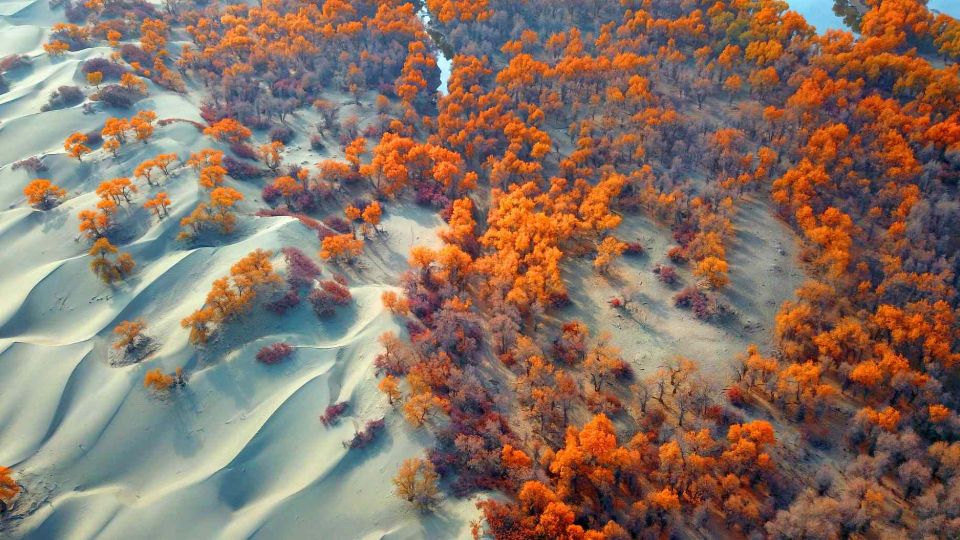
Tarim Populus Euphratica Forest is located in the Tarim River basin on the northeastern edge of the Taklamakan Desert. It is the largest primeval forest park in Xinjiang. Here you can not only see the trees and forests but also see the golden ocean. But the golden ocean is only available for a short time, about 20 days in mid-October. Although the time is short, the scenery is overwhelming.
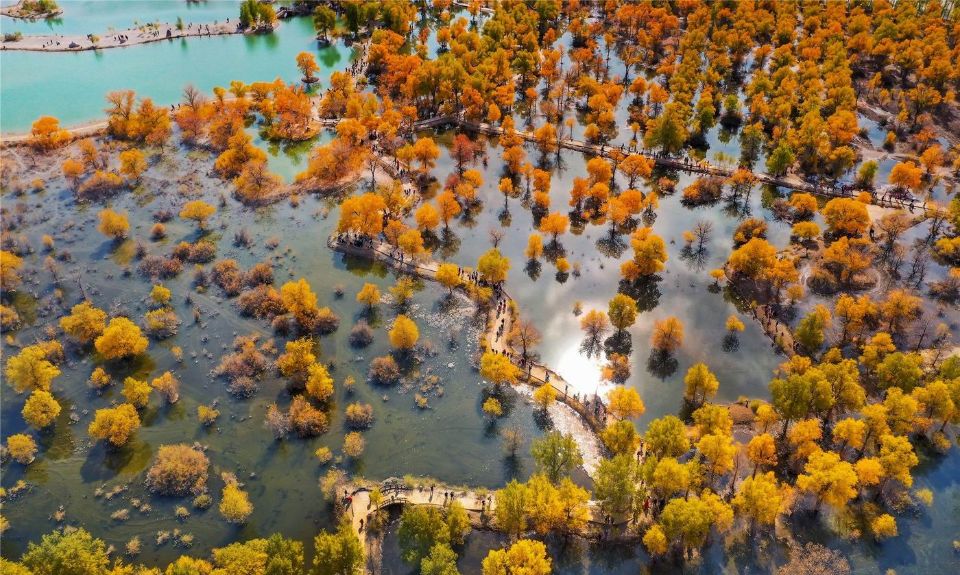
The Populus euphratica forest is like a thousand-year-old living fossil, standing tall and growing in the desert. Although only twisted tree trunks remain, it still declares to the world its tenacity and indomitability, and also makes people feel sorry.
Kunlun Mountains
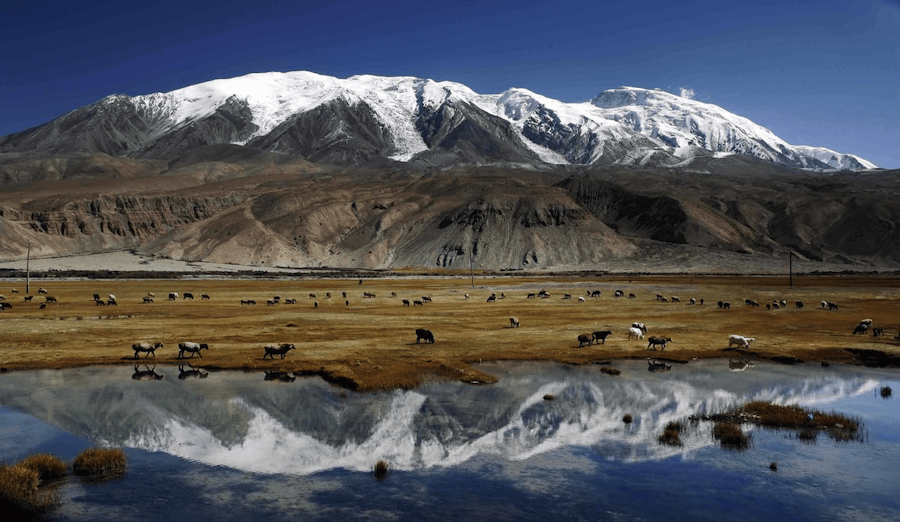
Kunluns is known as “China’s No. 1 sacred mountain” or “the ancestor of ten thousand mountains” and “the ancestor of the dragon vein”. The mountains are covered with white snow and the flawless snowflakes reflect colorful light under the sunlight.
Baisha Lake
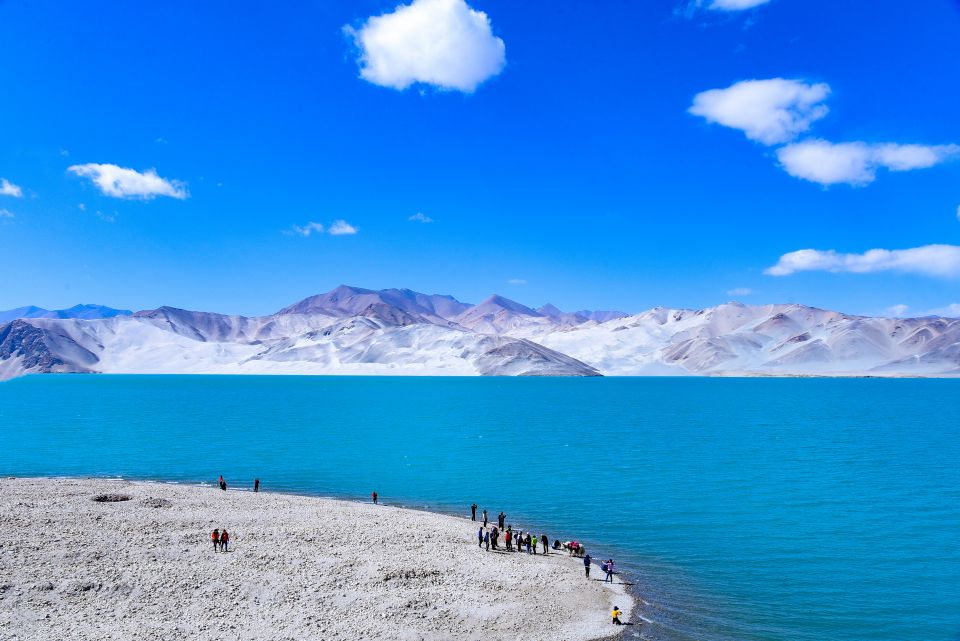
Baisha Lake has a water level that neither increases nor decreases all year round, hidden in the desert and surrounded by white sand mountains. Baisha is like a green gem in the middle of a white-gold land. There are clear water, blue sky and vast wild grasslands. The snow on the mountains melts into the lake surface, creating a dark blue color, the clear black lake reflects the snow-capped mountains.
Kizil Caves
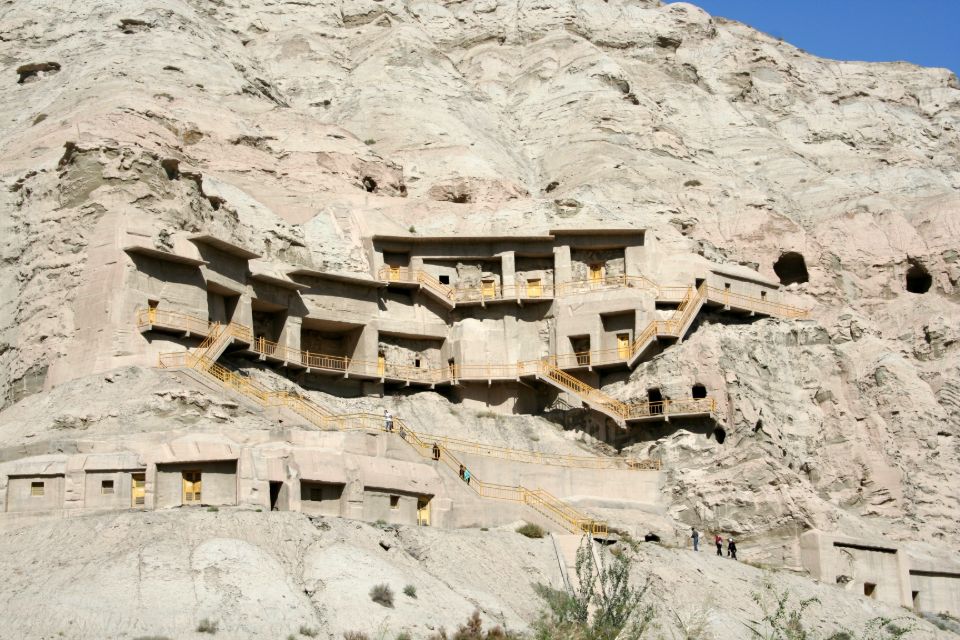
Kizil Caves are the oldest Buddhist caves in China, nearly 300 years older than the Dunhuang Mogao Caves. In the 236 numbered caves, many exquisite murals are left to explore the Buddhist culture, art and ancient lifestyle of the Qiuci Kingdom.
Kizil Caves, also known as the Kizil Thousand Buddha Caves, Kizil Cave-Temple Complex, are the largest surviving Buddhist rock caves in Xinjiang and the oldest, largest and westernmost Buddhist caves in China. The long construction period, complete architectural system, and well-managed Buddhist caves for different functions are a unique case in the world. The large-scale, rich content and long history of Buddhist art have earned the Kizil Caves the glorious title of “Treasure of Art”.

It is worth noting that it is a brilliant cultural heritage of the spread of Buddhism in China and the fusion of Eastern and Western cultures on the ancient Silk Road. In 2014, the Kizil Caves were listed as a World Cultural Heritage by UNESCO along with other ancient sites along the ancient Silk Road.
Apricot Valley
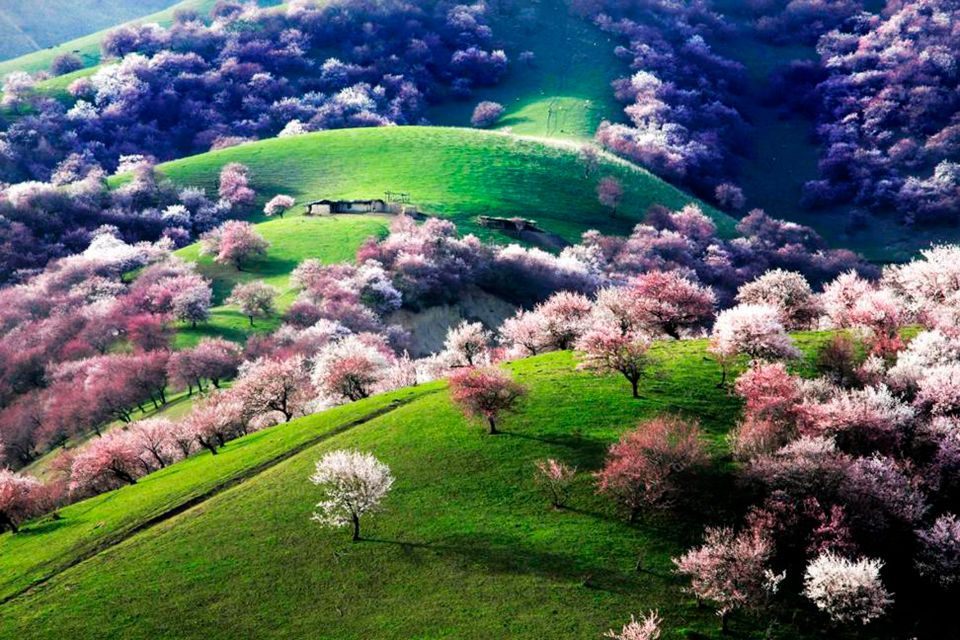
Apricot Valley, also known as Xinghuagou, is located in Turgen Town, Xinyuan County, Ili, Xinjiang. It is a relatively complete pristine wild apricot forest preserved since the medieval period. This is one of the areas with relatively concentrated plum forests in Xinjiang. The beauty of the plum valley lies in the splendor of the blooming flowers. In mid-April, the plum blossoms have begun to bloom and bloom in Turgen Town. In a week, they begin to bloom on the mountainside or at the bottom of the valley, forming a spring masterpiece of nature.
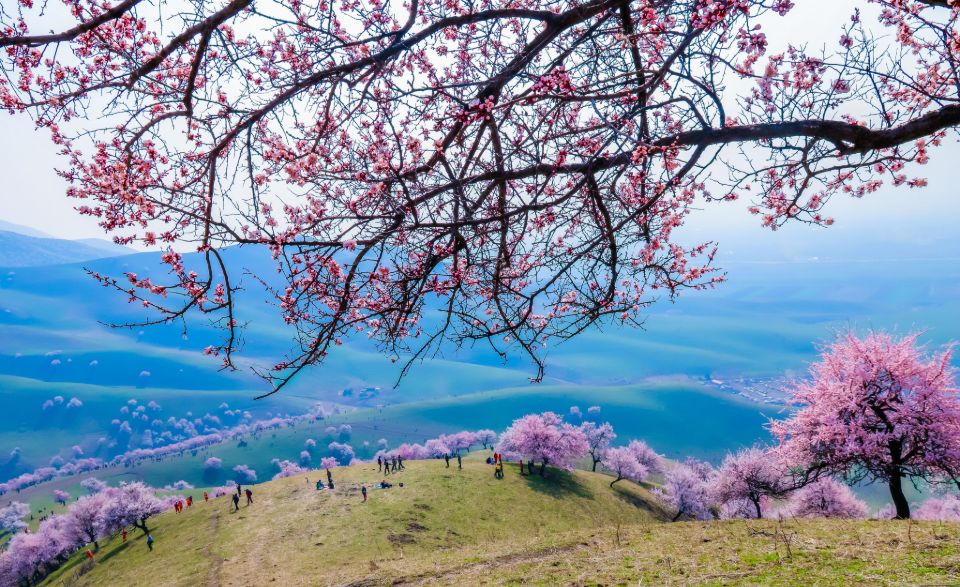
Five-Color Beach
The colorful beach is located next to the rippling Irtysh River, contrasting with the lush valley scenery on the other side. It can be said that this is “a river separated by two banks, with two skies”. The hills here have unique geology and have a variety of colors when the sunset shines on them, so they are called the Five-Color Beach.
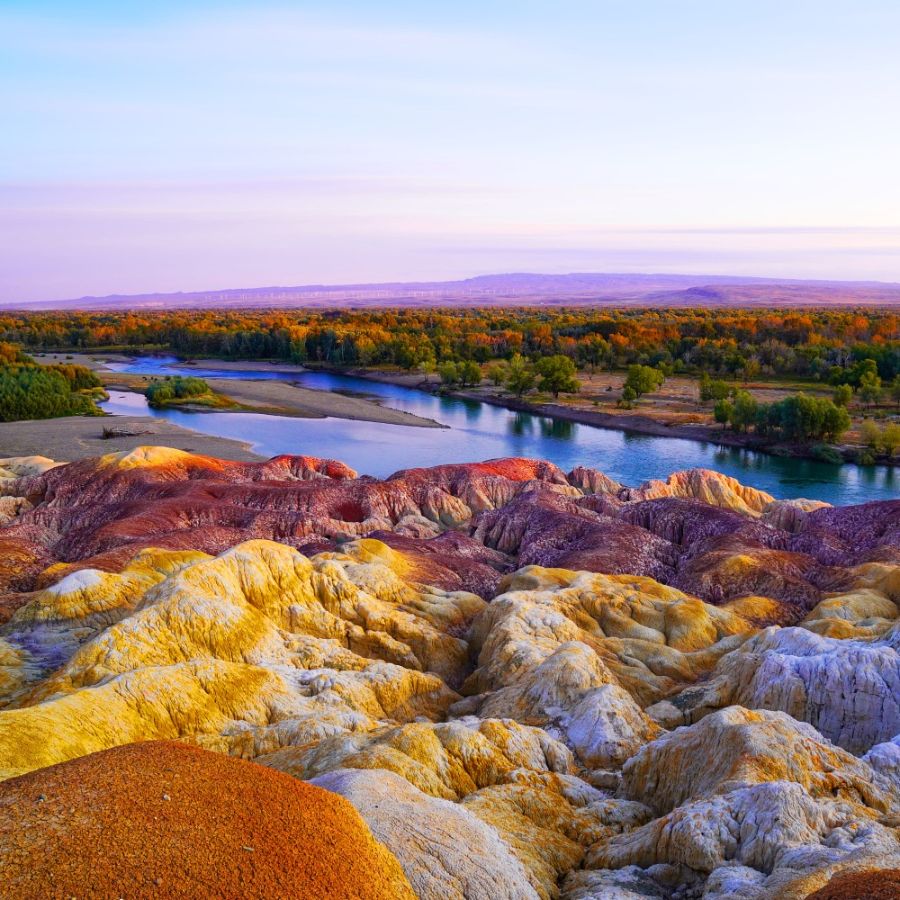
Five-Color Bay, located in the Wulumuqi region, is famous for its majestic and colorful natural scenery. There are beautiful mountains, grasslands, and lakes, all reflecting the wonderful colors of the surrounding sky and nature. From the capital city of Urumqi, you can travel to Five-Colored Bay by car or bus. The distance is about 150 km, taking about 3-4 hours to drive. You can rent a car or use the tourist bus service from the city center.
What to eat in Xinjiang?
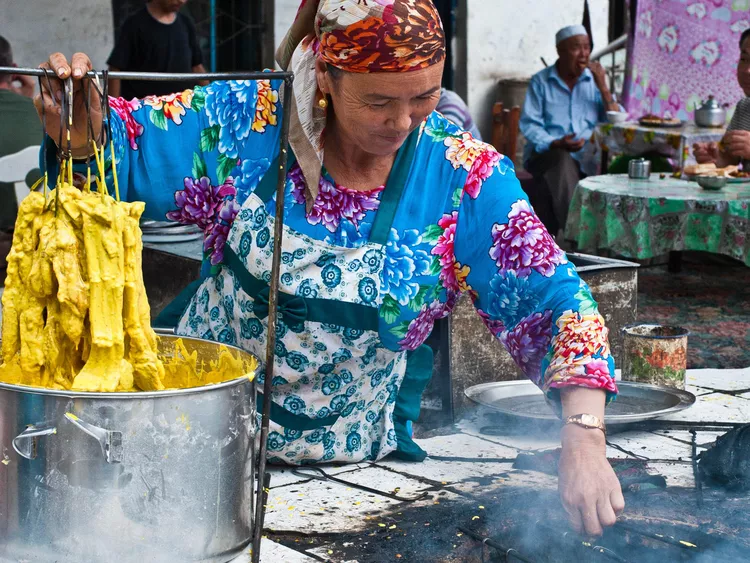
Like the dietary styles of Gansu and Qinghai in Northwest China, Xinjiang Cuisine features wild and large portions. Starchy foods and lamb are the mainstays. Try some local dishes and snacks to understand the culinary culture in Xinjiang. Dapanji, grilled and boiled lamb are popular local dishes. Meat lovers will love Xinjiang if you are satisfied with its taste. Many homemade snacks in the markets and night markets are also interesting to try. Besides, the high-quality pasture makes Xinjiang’s dairy products much richer and tastier than the others you have ever try.
Pilaf
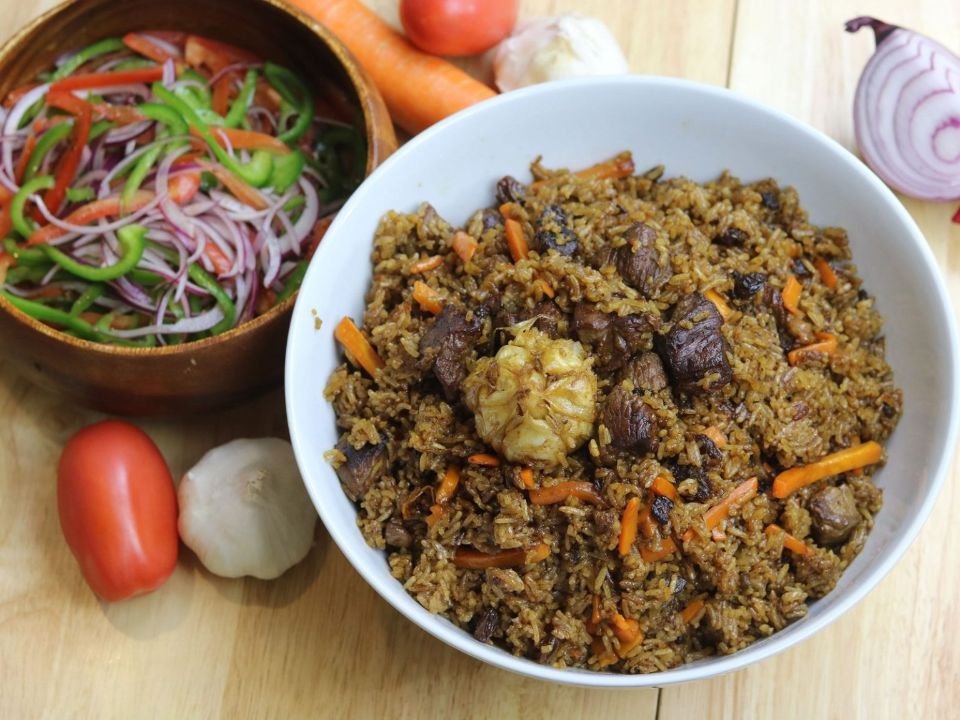
Pilaf is considered a popular dish in Central Asia and Xinjiang, made from rice, lamb or beef, carrots, onions, chili and spices such as pepper, star anise and salt. This dish is aged in oil for a long time, giving it a rich and delicious flavor. Pilaf is a popular and attractive choice not only for locals but also for tourists to enjoy.
Usually when eating Pilaf, you will be accompanied by a plate of pickled vegetables or sour cucumbers, creating a balance for the fatty flavor of the dish and cleansing the mouth. With a price of about 20 yuan, Pilaf is a popular and attractive choice not only for locals but also for tourists to enjoy.
Laghman Noodles
Lagman is a famous noodle dish of the Uyghur people. Lagman noodles are made from common ingredients such as flour, water, salt and oil but are chewy, soft and very delicious. This noodle dish is usually served with a sauce that includes onions, peppers, lamb, vegetables, and spices such as pepper and paprika. It costs between 15 and 25 yuan per portion.
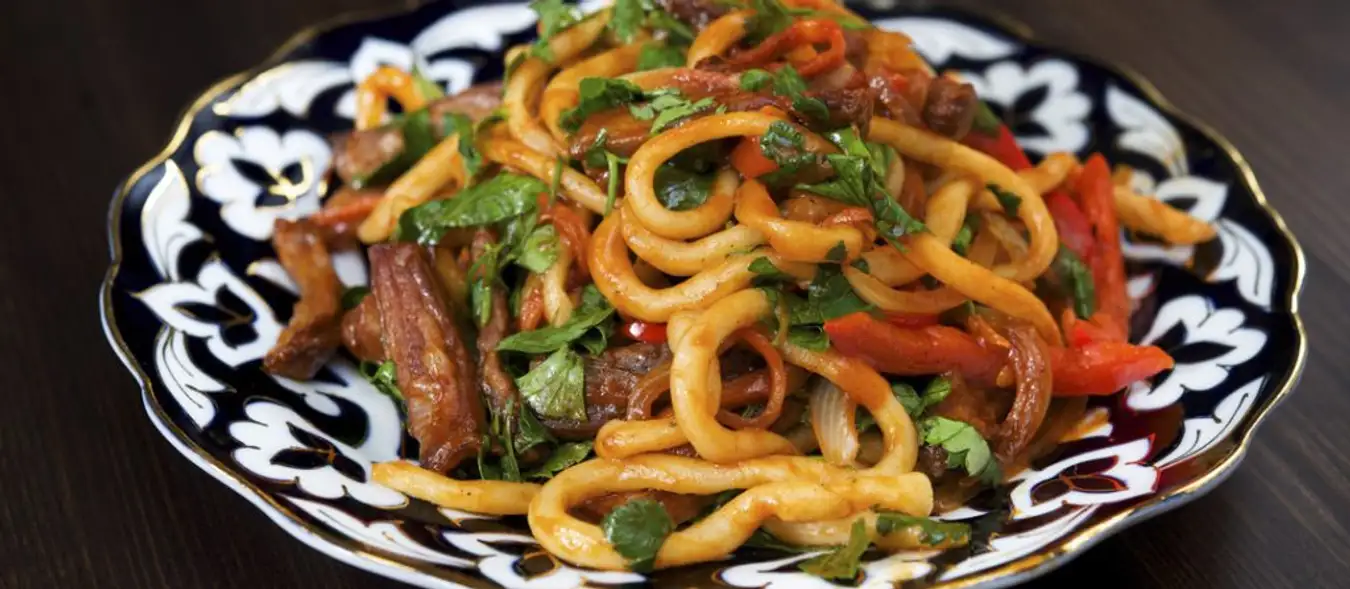
Xinjiang Big Plate Chicken (Stewed Chicken Soup)
Xinjiang Stewed Chicken Soup (or dapanji) is one of the top dishes for tourists who want to experience Xinjiang cuisine.
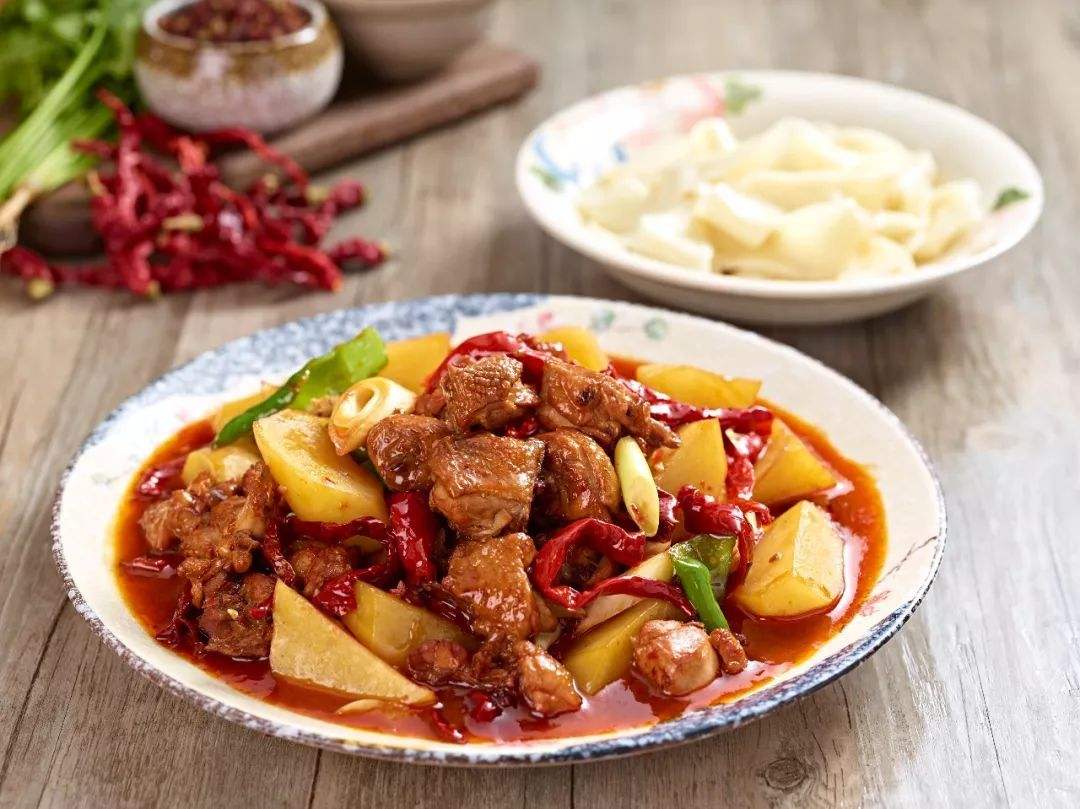
Xinjiang Big Plate Chicken is a famous dish of the local people here, with a wonderful combination of chicken and vegetables such as potatoes, bell peppers, onions. This dish is not only delicious but also rich in flavor thanks to the typical spices such as star anise, Sichuan pepper and dried chili. Xinjiang Chicken is prepared by stewing chicken with vegetables and spices, creating a spicy, flavorful and attractive dish.
This dish includes a large plate of potatoes, peppers, a whole chicken, and various spices. Xinjiang Stewed Chicken Soup is quite spicy. For the full experience, order some Uyghur naan to eat with this soup.
Grilled Lamb
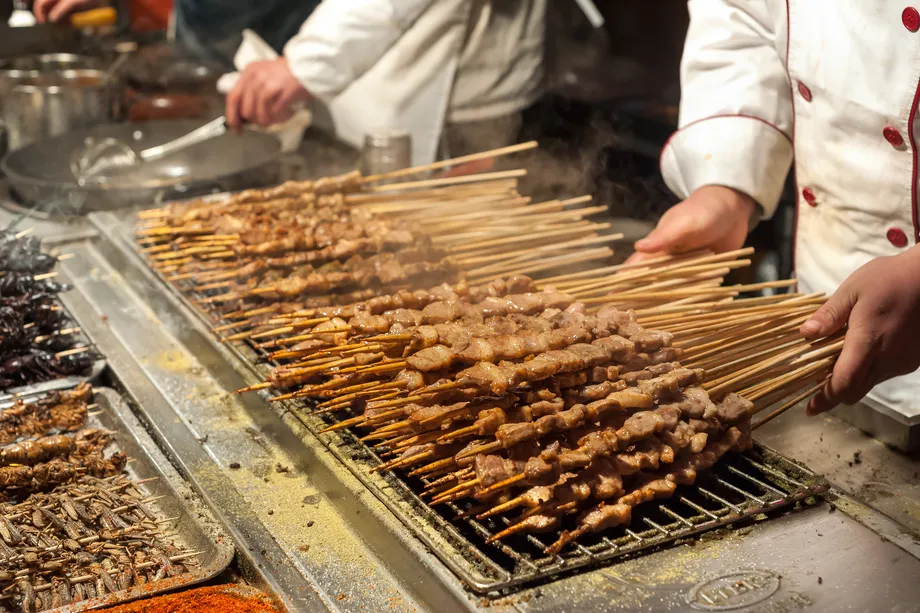
When it comes to Xinjiang cuisine, how can we not mention grilled lamb skewers? Xinjiang grilled lamb uses high-quality lamb, cut into small pieces, marinated and skewered on a special grill. During the grilling process, the lamb skewers give off an alluring aroma that makes diners drool.
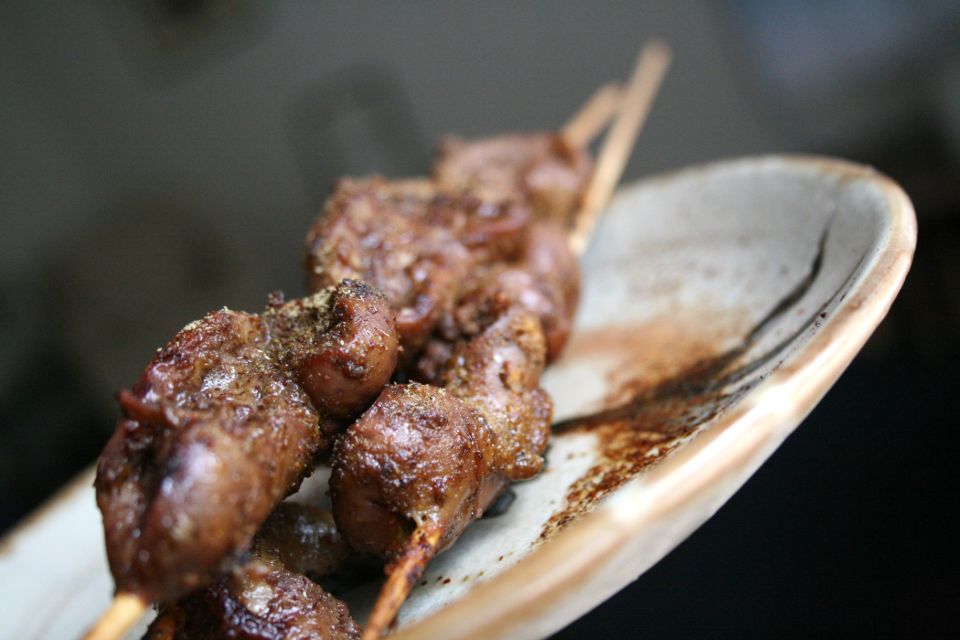
Lamb Kebab is a famous street food in Xinjiang, and you will easily come across fragrant grilled skewers at night markets or on the streets. Kebab is made from fresh lamb pieces, carefully marinated with spices such as cumin, pepper, chili and ginger. These skewers are then grilled over charcoal, creating a crispy outer layer while retaining the meat’s natural softness and sweetness.
Lamb kebab is famous for its rich flavor, combining the spicy taste of chili and the characteristic aroma of cumin. After being grilled, the lamb has a slightly crispy outer layer, while the inside is soft and soaked in spices, creating a unique and very “appetizing” flavor. This is an ideal dish for evening walks in Xinjiang, helping you experience the local life and culinary culture in the most authentic way.
Mixed Fried Rice
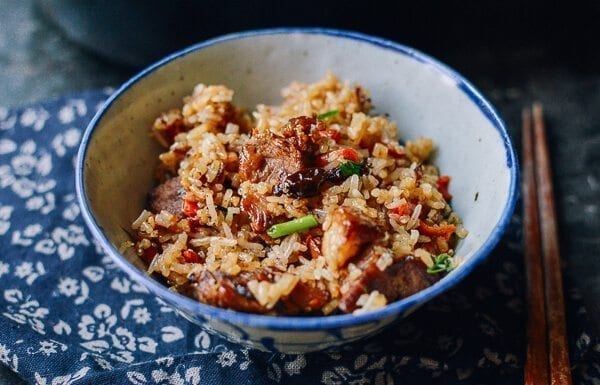
This dish is made from lamb cooked with onions and yellow carrots – a type of carrot that is only found in Xinjiang. The meat and vegetables are cooked with a number of spices, including dill, and then steamed with rice. Sometimes you will see raisins added to give the dish a salty-sweet taste.
Hemp Candy
Hemp Candy, Cut Cake (Uyghur Matang) is one of the most popular Uyghur street foods that you can find all over China, not just in Xinjiang province. Usually, you will see a cart with a variety of matang pre-cut and available for purchase.
Hemp candy is made with different nuts (almonds, walnuts, cashews, etc.) available in Xinjiang, combined with honey.
Samsa – Uyghur Baked Buns
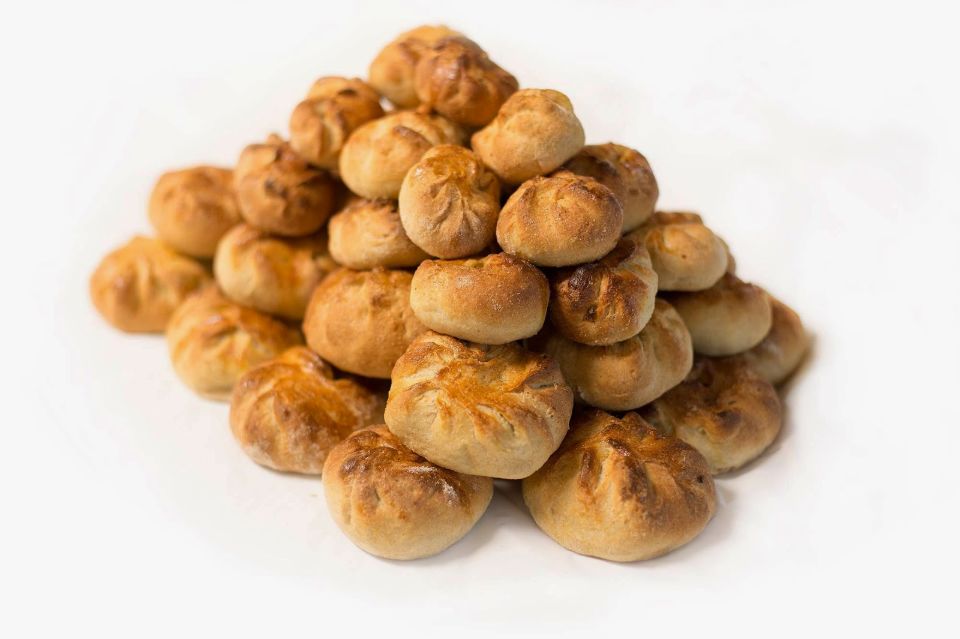
Samsa is a famous Uyghur pastry, often enjoyed as a snack or tea party. Samsa is shaped like a dumpling but is baked instead of steamed. The filling is made from minced lamb, onions and special spices, creating a rich and distinctive flavor of the dish.
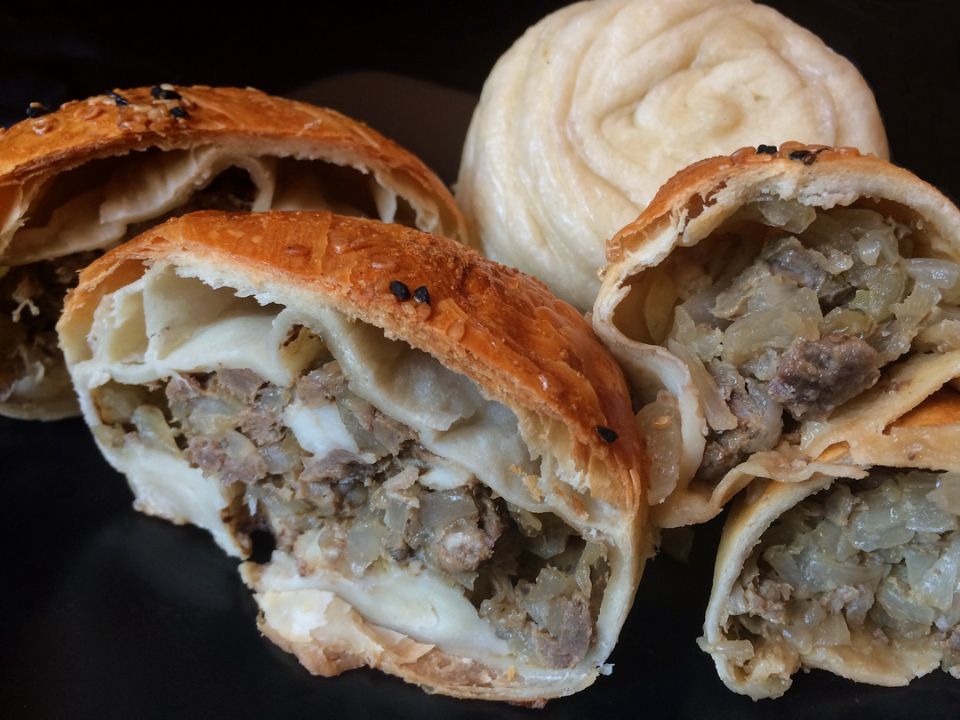
Naan Bread

When traveling to Xinjiang, you should not miss Naan bread, a popular dish eaten with many different dishes, from grilled dishes to stews and curries. The delicious flavor and characteristic crispiness of Naan bread have made it a favorite and indispensable dish when exploring Xinjiang cuisine.
Xinjiang Red Dates
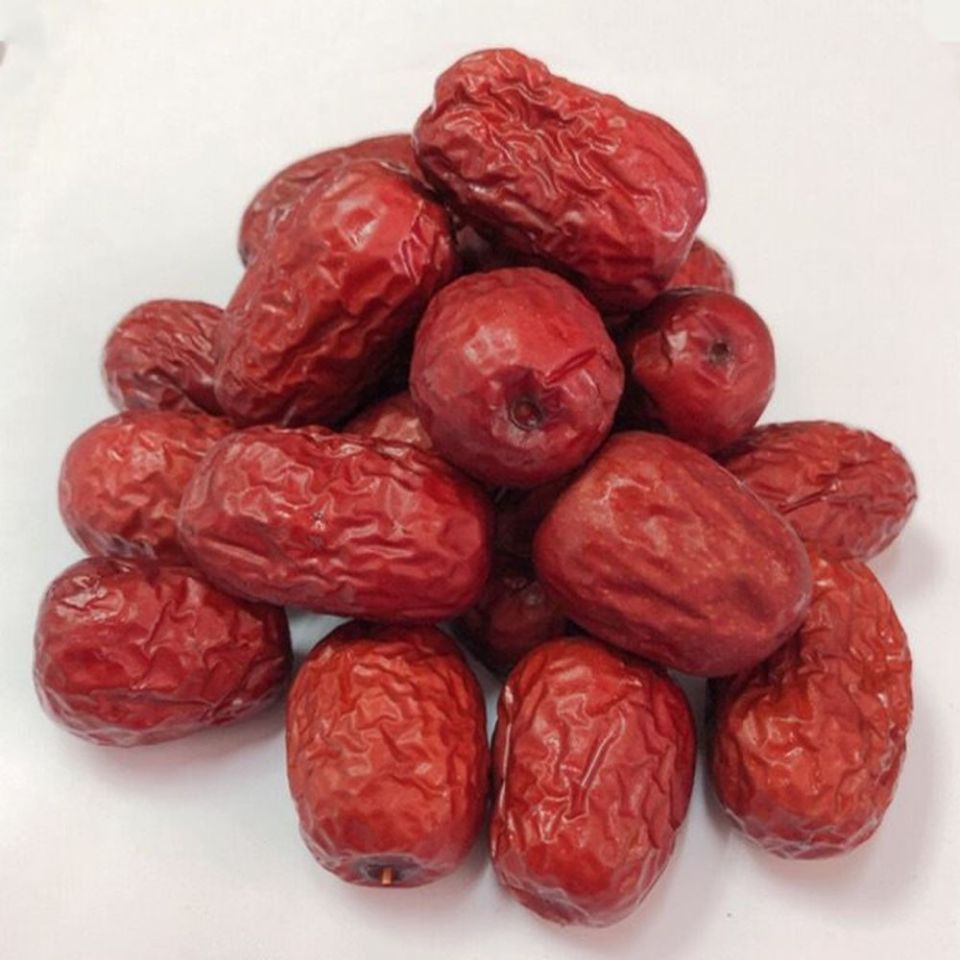
Xinjiang Red Dates is not only delicious but also has extremely high nutritional value. It is rich in calcium, iron, phosphorus and other minerals and vitamins. Xinjiang red dates are very large and sweet. Not only that, Xinjiang red dates also have profound cultural significance. In Uyghur folklore, Xinjiang red dates symbolize faithful love, lasting happiness and are indispensable auspicious objects in people’s weddings.
Xinjiang Fruits
Thanks to its special geographical location and the huge temperature difference between day and night, Xinjiang produces many delicious fruits and melons, including Turpan grapes, Korla pearls, Hami melons, Aksu apples, Yechen pomegranates and apricots, figs, and Xinjiang South melons. Nuts such as Badam, red dates, etc., you can taste them at major attractions and buy some at local markets.
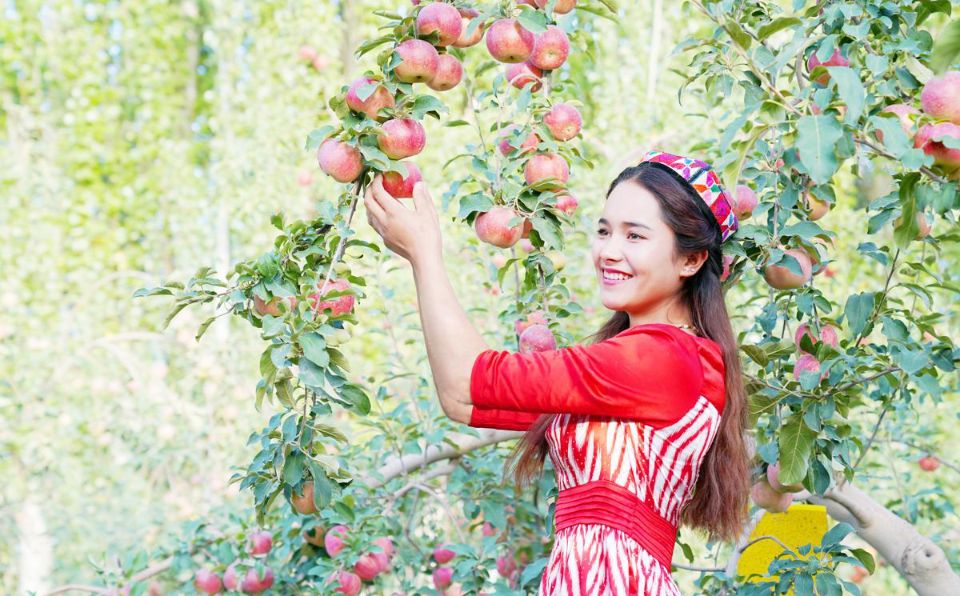
Xinjiang is not only famous for its traditional dishes but also a paradise of delicious fresh fruits. Thanks to the hot, dry climate during the day and cool at night, fruits in Xinjiang are especially sweet and juicy.
Some famous fruits here include: cantaloupe, watermelon, figs, grapes, apples and pomegranates. These fruits not only help cool down in the harsh heat of Xinjiang but also provide many vitamins and nutrients necessary for the body.
Yogurt

Yogurt is an indispensable dish in the daily meals of Uyghurs and ethnic minorities in Xinjiang. Yogurt is made from sheep’s milk or cow’s milk, going through a natural fermentation process, bringing a rich, slightly sour and very cool flavor.
The biggest difference between Xinjiang yogurt and regular yogurt is its natural thickness and rich flavor, because it is made from pure milk and not industrially processed. Yogurt and fruit deserve to be enjoyed more by tourists when coming here!
Where to stay in Xinjiang?
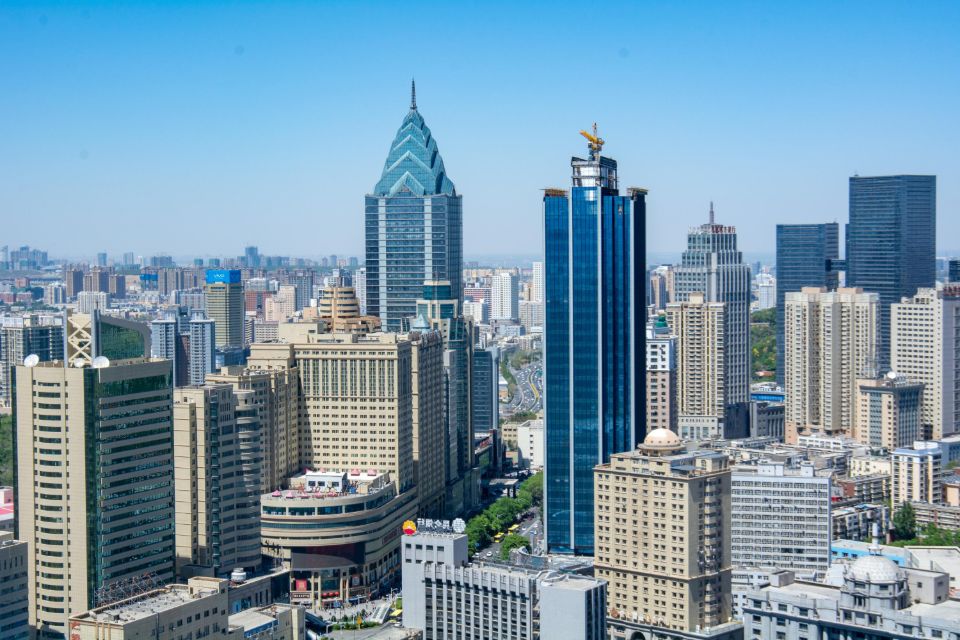
Apart from a few major cities such as Urumqi (Agoda, Booking), Kashgar (Agoda, Booking) and Turpan (Agoda, Booking), hotels in these Xinjiang cities are fully equipped with amenities and wifi. In many other places, especially some remote scenic spots, accommodation is relatively simple and expensive. You can also stay in homestays or local cabins (Kanas and Hemu) to deeply experience local customs. In addition, during the winter season from June to August every year, hotel occupancy will be much higher than usual, so you need to book in advance.
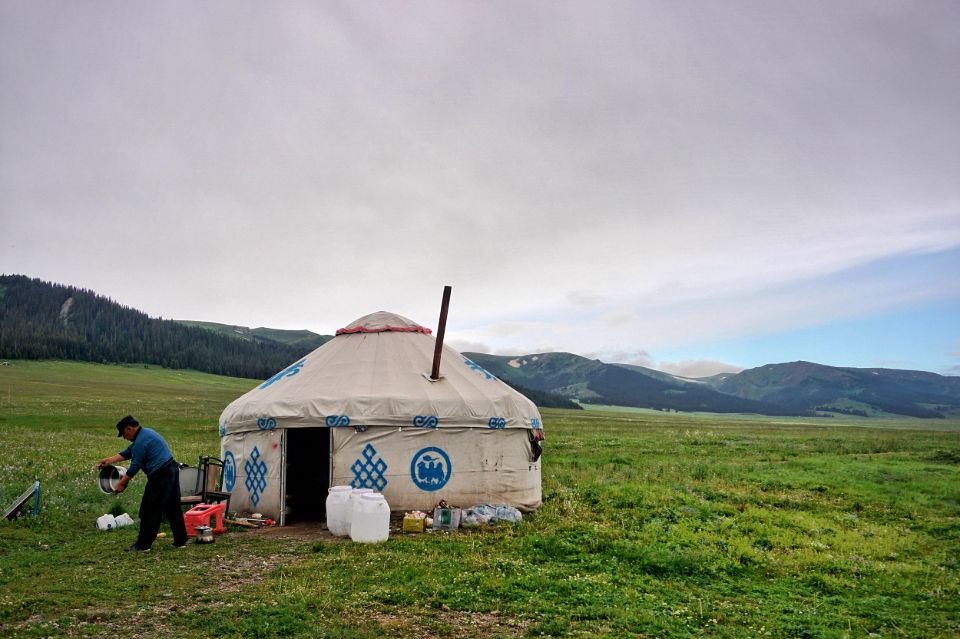
Xinjiang has many different accommodations, options and conditions, depending on your travel itinerary, budget and personal preferences. Major tourist destinations such as Urumqi, Kashgar and Turpan have quite good accommodation. You can choose from star-rated hotels with full facilities and clean, comfortable rooms, to mid-range guesthouses and local budget guesthouses. Generally, the downtown area is the best place to stay overnight. Kashgar Old Town has many uniquely decorated hotels.
In remote mountainous scenic areas, such as Kanas Lake & Hemu Village, Ili grasslands, Sayram Lake in Bortala, accommodation is limited and standard dormitories as well as special ethnic yurts with simple facilities are the main choices. If you visit Hemu Village, you can stay overnight in a Tuva wooden house to experience traditional architecture and enjoy the countryside scenery outside.
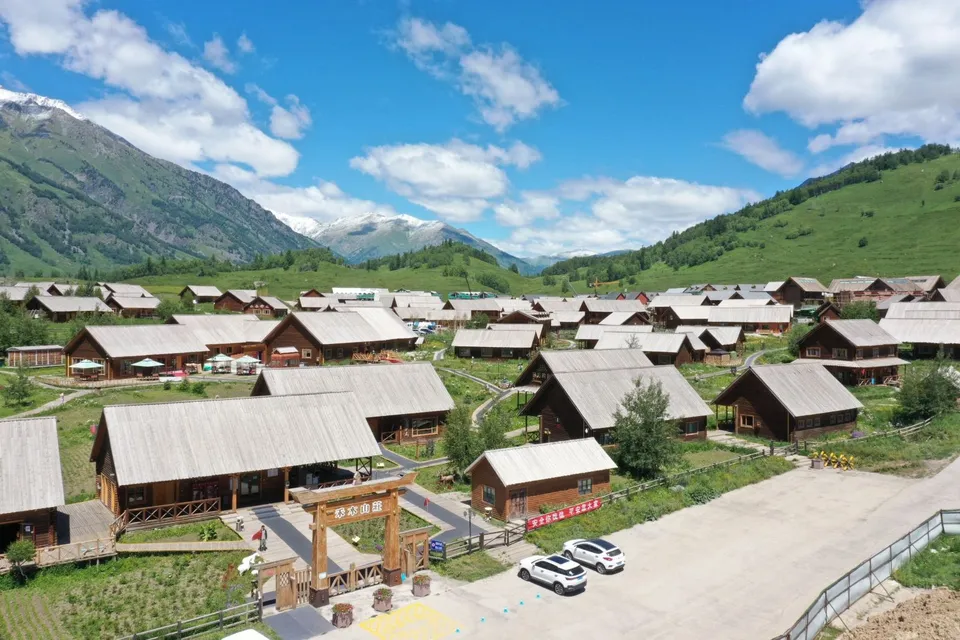
Suggestions for accommodation during peak season
- During peak season, hotel prices increase, which is relatively expensive. Sometimes there are no rooms available, so we have to book in advance.
- If you book a hotel through a travel agency, it will be cheaper than booking it yourself, but make sure you find a travel agency with good organization and service.
- In some remote hotels, the items provided may not be complete. Some toiletries and towels are not available.
- If you want to go out and set up a tent, please ask for professional advice and local policies in advance, and ensure the legality and safety of your trip in advance.
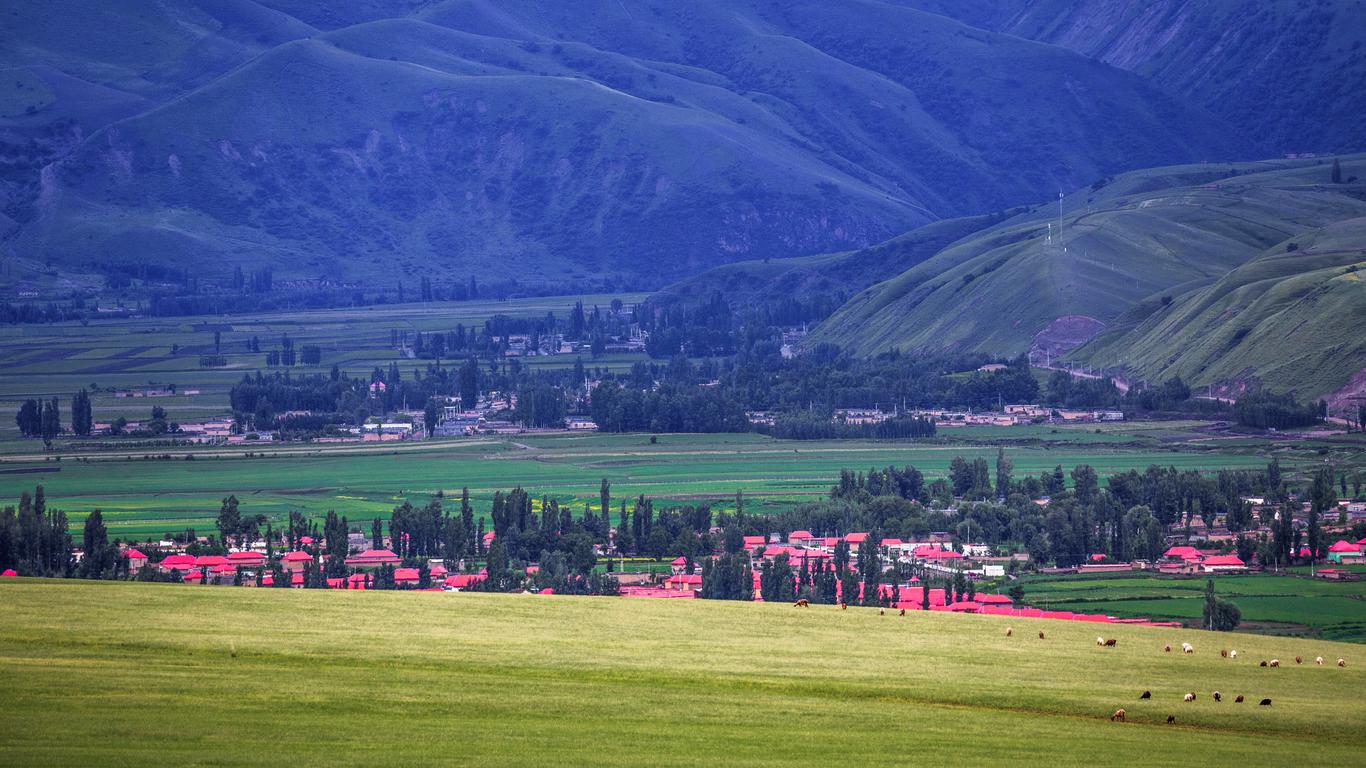
What souvenirs to buy in Xinjiang?
Xinjiang is one of the popular shopping destinations in China. You can find many unique and interesting goods here. Here are some suggestions for gifts when visiting Xinjiang:
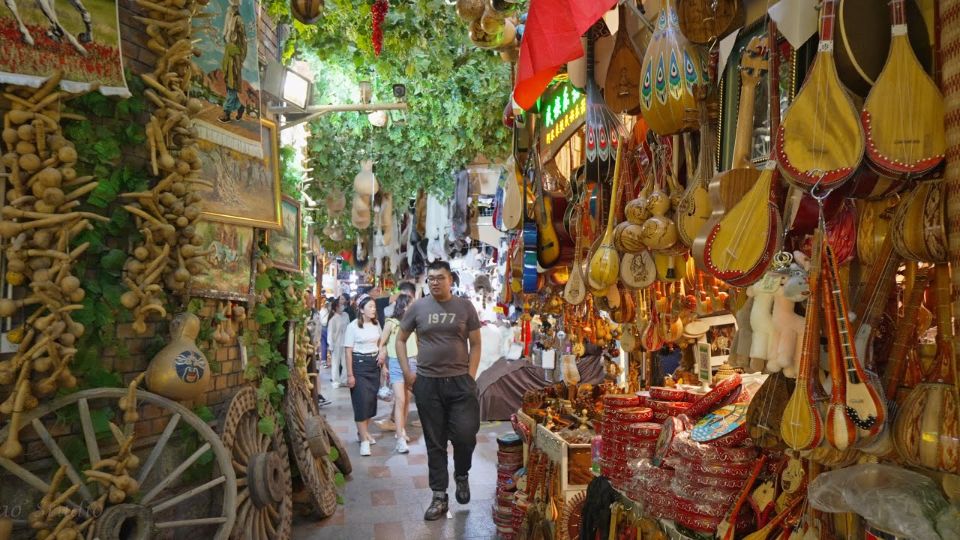
- Bat Trang porcelain: Bat Trang is a traditional craft village of Vietnam, but you can find these products in Xinjiang. Bat Trang porcelain is hand-made with high-quality materials and beautiful designs.
- Woolen clothes: Xinjiang is one of the leading wool producers in China. You can find many different designs and styles, from turtleneck sweaters to thick coats.
- Biscuits: Xinjiang has many delicious and unique traditional biscuits such as sugar-shaped biscuits, spicy biscuits, cereal biscuits, etc.
- Oil paintings: Xinjiang is one of the leading oil painting production places in China. You can find many beautiful and good quality oil paintings, suitable for home display.
- Dried fruits: Of course, as a paradise of fruits, you can buy dried fruits as gifts such as: red dates, raisins, apricot, plum
- Handicrafts…
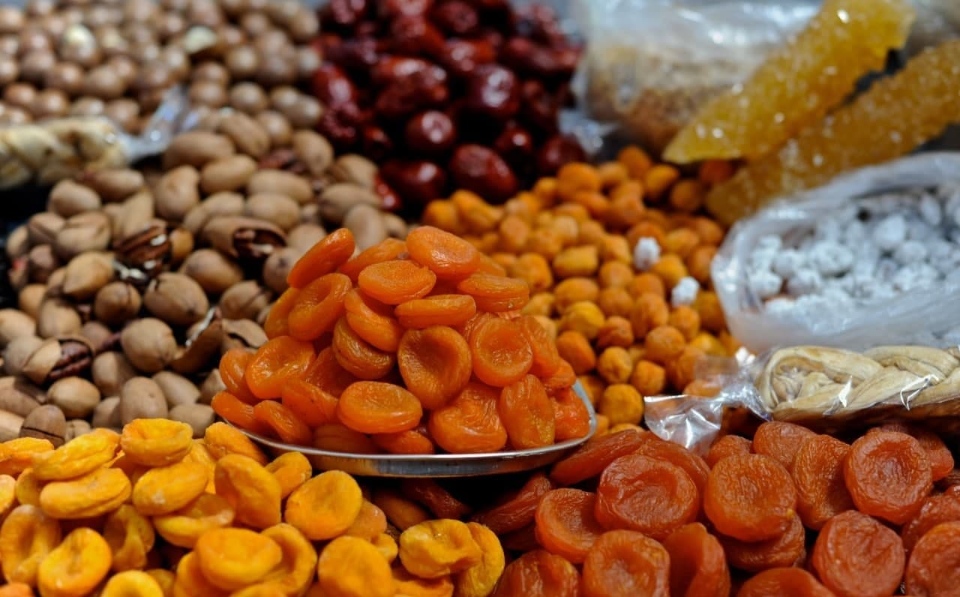
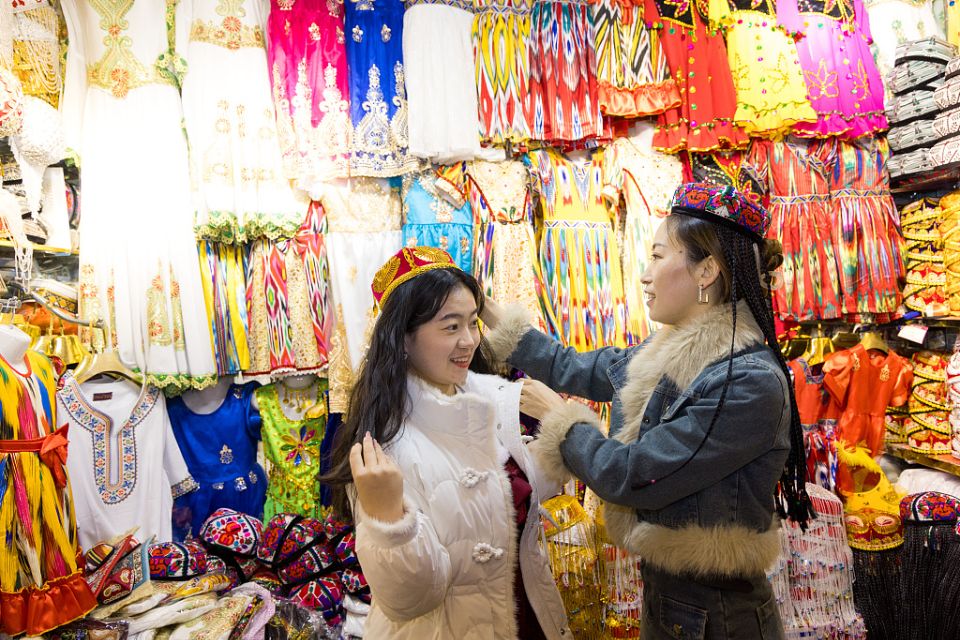
All the suggestions above are typical gifts of Xinjiang, helping you bring your relatives and friends a unique and meaningful gift. For more details you can read the article where we compiled best things to buy in Xinjiang here.
What items are necessary for a trip to Xinjiang?
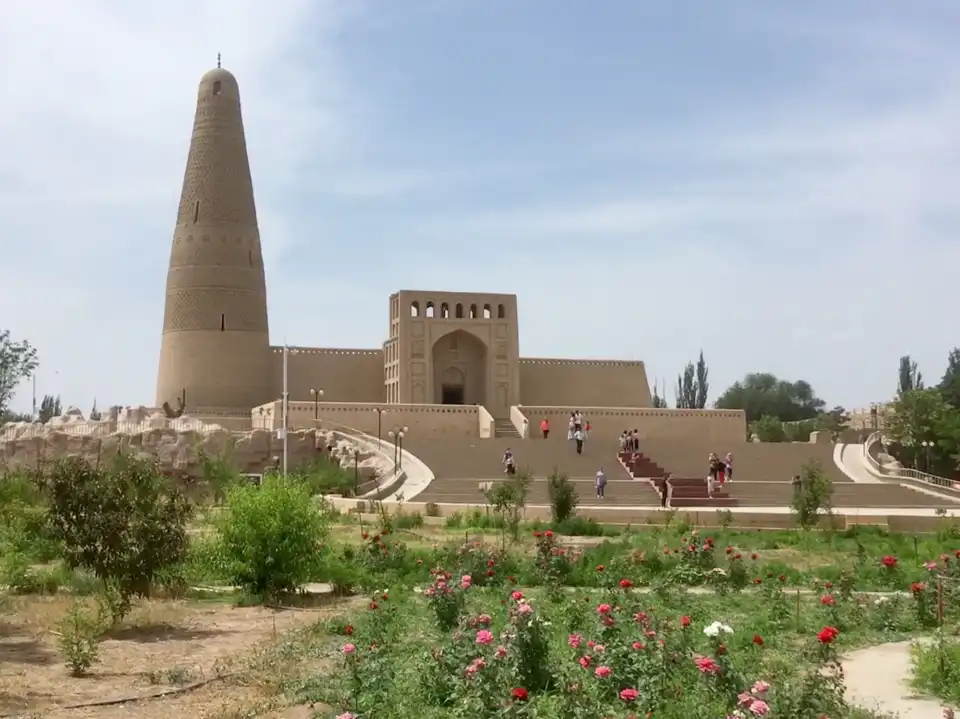
- Clothes: Due to the large temperature difference between day and night in Xinjiang, you should bring some extra layers of clothes to keep warm. Long sleeves and long pants are a must; you need to cover as much exposed skin as possible when outdoors. Winter clothes and sun protection clothing are recommended for all seasons of travel.
- Shoes: sandals, comfortable sneakers, hiking shoes (waterproof is best)
- Sunblock: sunscreen or spray with high SPF, sunhat, sunglasses
- Hydration: Skin care products, lip balm, hand cream and moisturizer.
- Snacks: Energy bars, chocolate, instant noodles, etc.
- Water: it is best to bring some bottled water and a water bottle.
- Medication: Motion sickness pills, Vitamin supplements, other necessary medications.
- Documents: Your valid documents such as passport, visa, etc.
What are the common payment methods in Xinjiang?
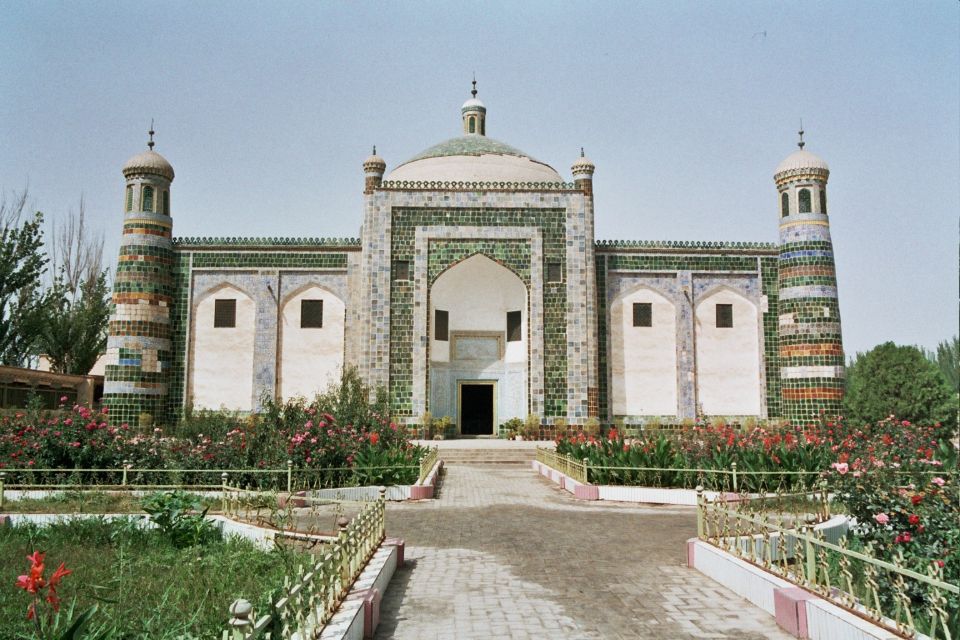
You can use Alipay and WeChat to pay in most areas. Some scenic spots and highway toll stations can only be paid in cash, so you may need to bring some CNY cash. Credit cards are not recommended as a payment method in Xinjiang.
Some more information about: Shopping, Insurance, Taboos, Time difference

- Shopping: In most areas of Xinjiang, the price of goods is quoted in kilograms (except Hotan in southern Xinjiang), so please confirm whether the price is quoted in kilograms or half a kilogram when purchasing goods by weight. When purchasing tourist souvenirs at the market (market), please negotiate and give feedback after confirming the purchase. Bargaining without purchasing may lead to dissatisfaction with the seller.
- Taboos: When entering Muslim families or restaurants, do not talk about taboo meals such as pork, and it is best not to drink alcohol or smoke; It is forbidden to take photos in religious areas. Pay attention to your words and actions to avoid unnecessary trouble. Xinjiang is an area where many ethnic minorities live.
- Insurance: It is best to have accident insurance before traveling, especially in some desert areas.
- Time difference: There is a two-hour difference between Xinjiang and other provinces in China, but all of Xinjiang use Beijing time for work and rest. Generally speaking, it is not too late to sleep in Xinjiang. It is now midnight, and normal working hours in the morning start at 10:00.
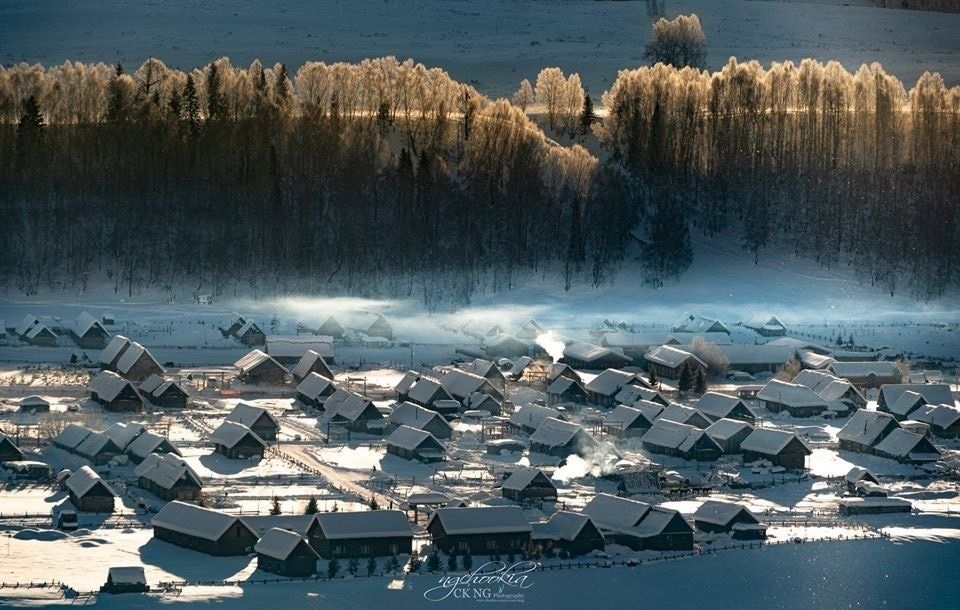
Pocket tips when traveling to Xinjiang

On your journey to Xinjiang, exploring the mysterious land of Mainland China, you need to note the following:
- Buy a Chinese 4G SIM card in advance for convenient use when finding your way, searching for information and communicating with local people.
- Security in Xinjiang is strictly controlled, there are often checkpoints at train stations and tourist attractions. Therefore, you always need to bring your passport and a copy of your passport when traveling.
- Xinjiang is a large territory with diverse terrains, it will be safer if you travel on a Xinjiang tour with the support of a local guide.
- If you want to travel to many places in mainland China, avoid buying Uyghur knives in Kashgar. Because when you board a train or plane to other locations, customs can immediately confiscate this type of knife. Uyghur knives are not allowed to be taken out of Xinjiang by air, even when checking in luggage. The only way to bring them back to your home is by road.
- When visiting Islamic sites, dress modestly and modestly, avoiding short clothing. Bring a large scarf to use when needed. Always ask permission before taking photos with local people to show respect for local culture and regulations.
- Avoid eating food of unknown origin or eating undercooked food. This can lead to health problems such as diarrhea or epidemics.
- Avoid contact with wild animals, including raccoons, to avoid the risk of being attacked or infected.
- Avoid entering dangerous or restricted areas. For example, military areas or areas devastated by natural disasters.
- Avoid buying goods from unofficial stores or unlicensed street vendors. The products may not be of good quality or meet international standards.
Avoid using unreliable services or unlicensed tours, to avoid being scammed or stranded in an unsafe place. - Avoid using unsafe means of transport, such as old buses or unmetered taxis.
- Avoid activities that may harm the environment, such as littering or destroying land or forests.
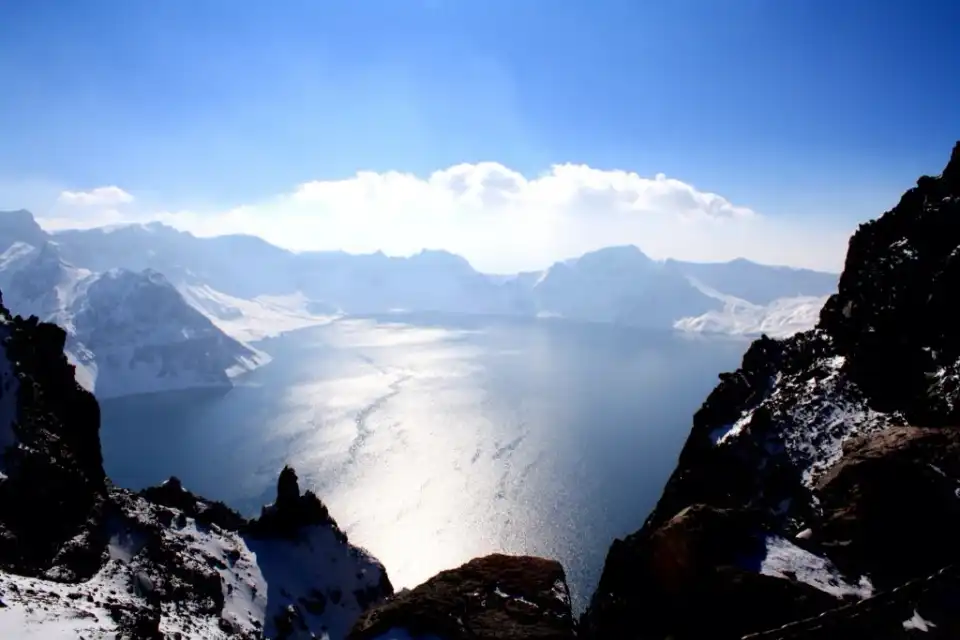
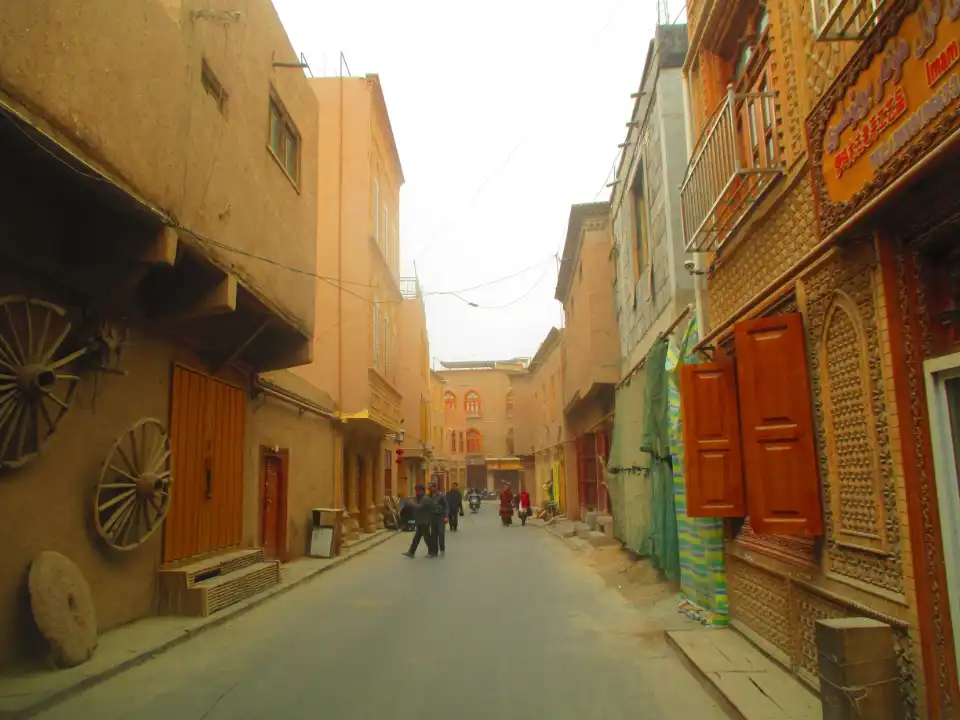
The post is complied by Living Nomads from many different sources. If you find any images or text that belong to you, please contact us, so we can credit you or give us permission to use them. Thank you very much!
Some best day tours, trips, activities and transfer services, tickets in, from and to Xinjiang you can refer to
- 9-day tour of Xinjiang’s three beautiful lakes
- Xinjiang 8-day trip to the snow
- Xinjiang Xueman Altay 5-day tour
- 5-day tour of Xinjiang’s secret Kashgar
- [Klook Ice and Snow Season] 8-Day Tour to Beishuang Lake in Altay, X
- Xinjiang Muxue Winter 5 days and 4 night
- 7 days and 6 nights in Xinjiang Snowy North
- Xinjiang private customization & special planning & team building customization
- Chartered tour Xinjiang Urumqi to Yili/Narathi/Xiata Ancient Road/Sailimu Lake multi-day chartered tour
- Xinjiang Winter Love Letter 8 days and 7 nights
- 8-day tour in southern Xinjiang
- Xinjiang Western Region Dream Return to Southern Xinjiang for 8 days and 7 nights
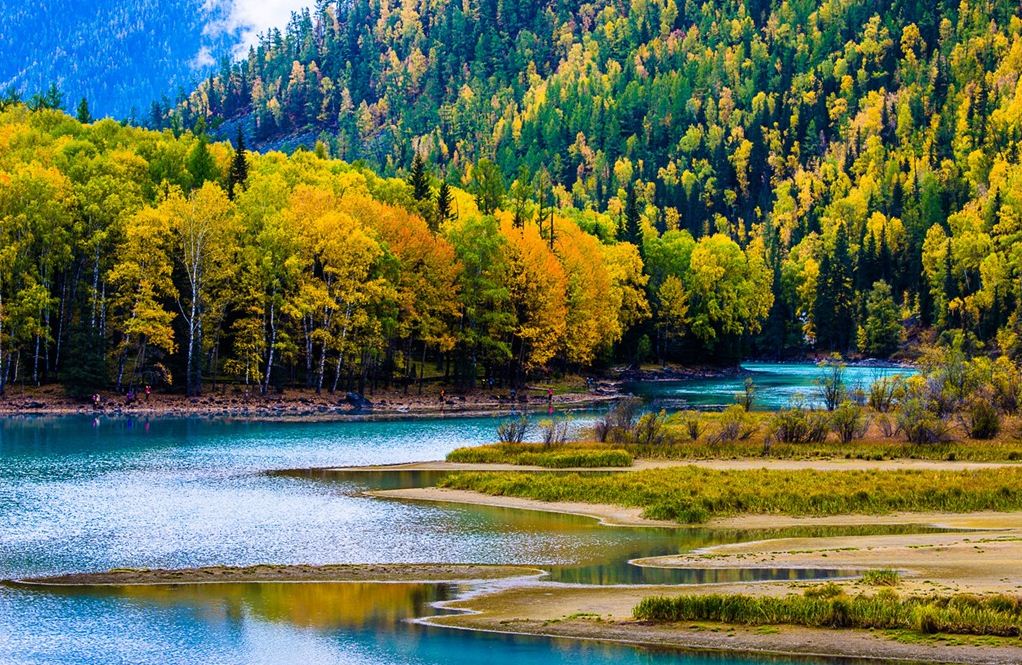
Read more Xinjiang here and China guide here.































![10 best airports in Asia in 2016 [RANKED] kuala-lumpur-international-airport-best airports in asia in 2016 by skytrax ratings](https://livingnomads.com/wp-content/uploads/2016/08/29/kuala-lumpur-international-airport-best-airports-in-asia-in-2016-by-skytrax-ratings-218x150.jpg)








